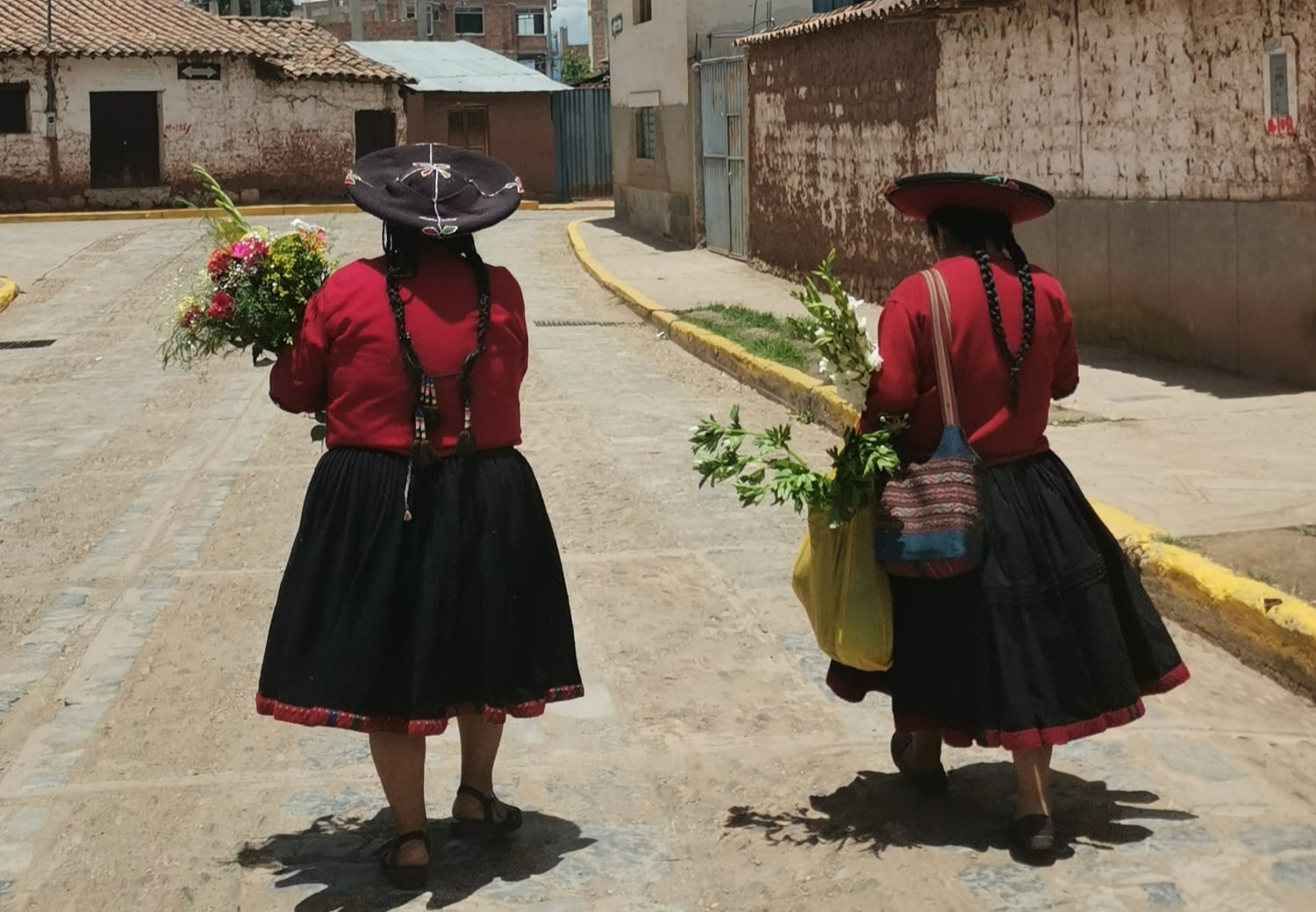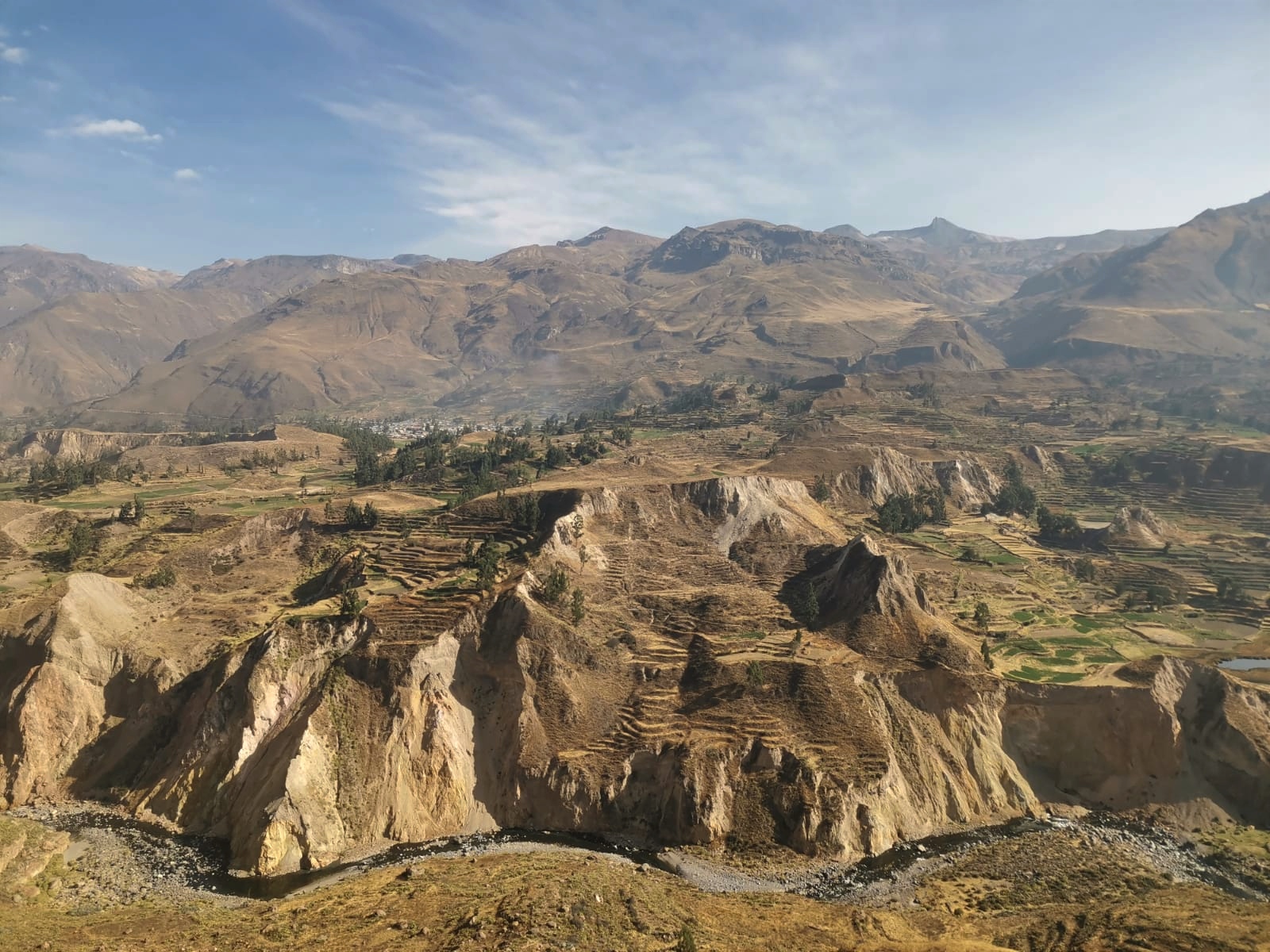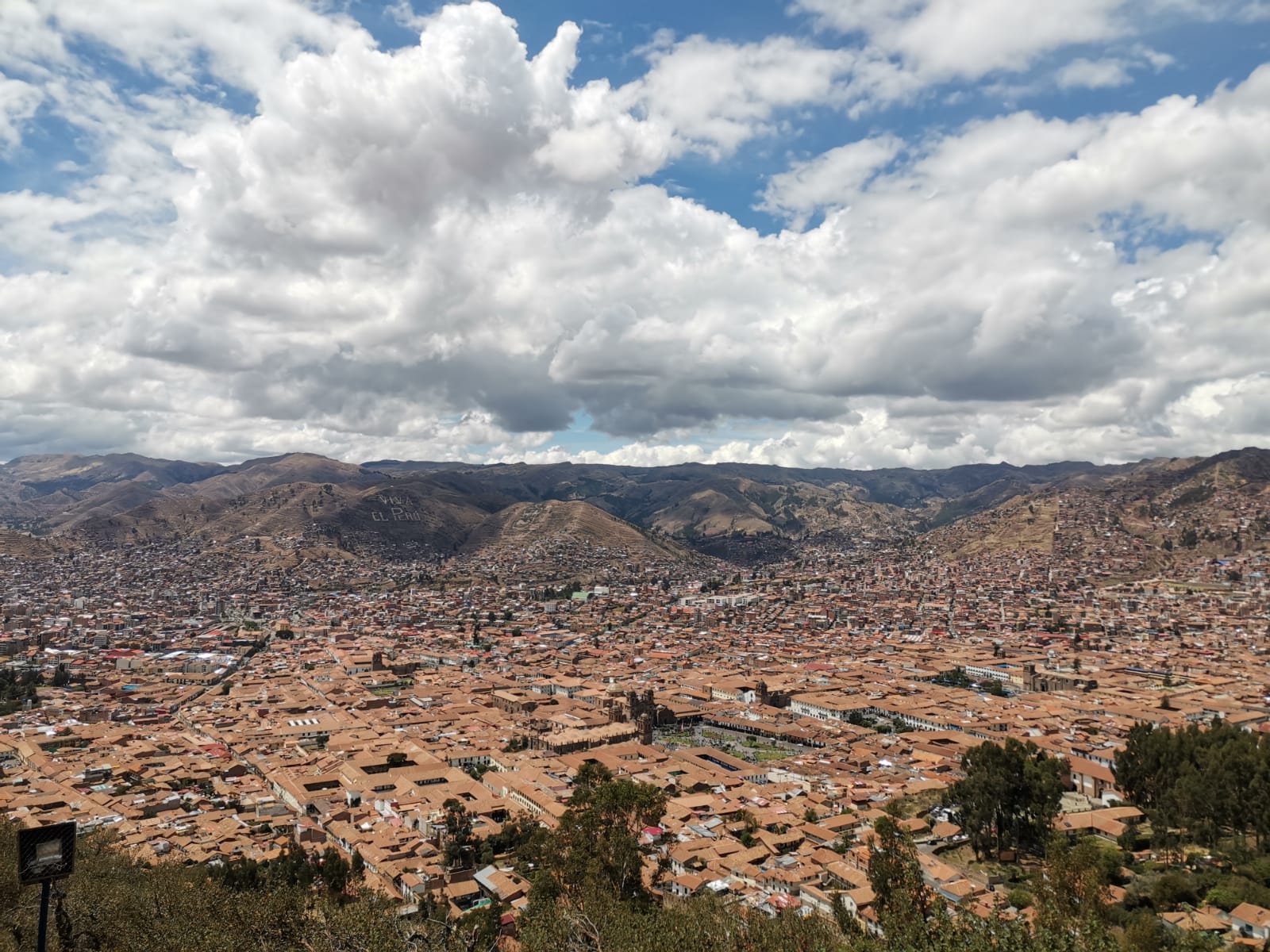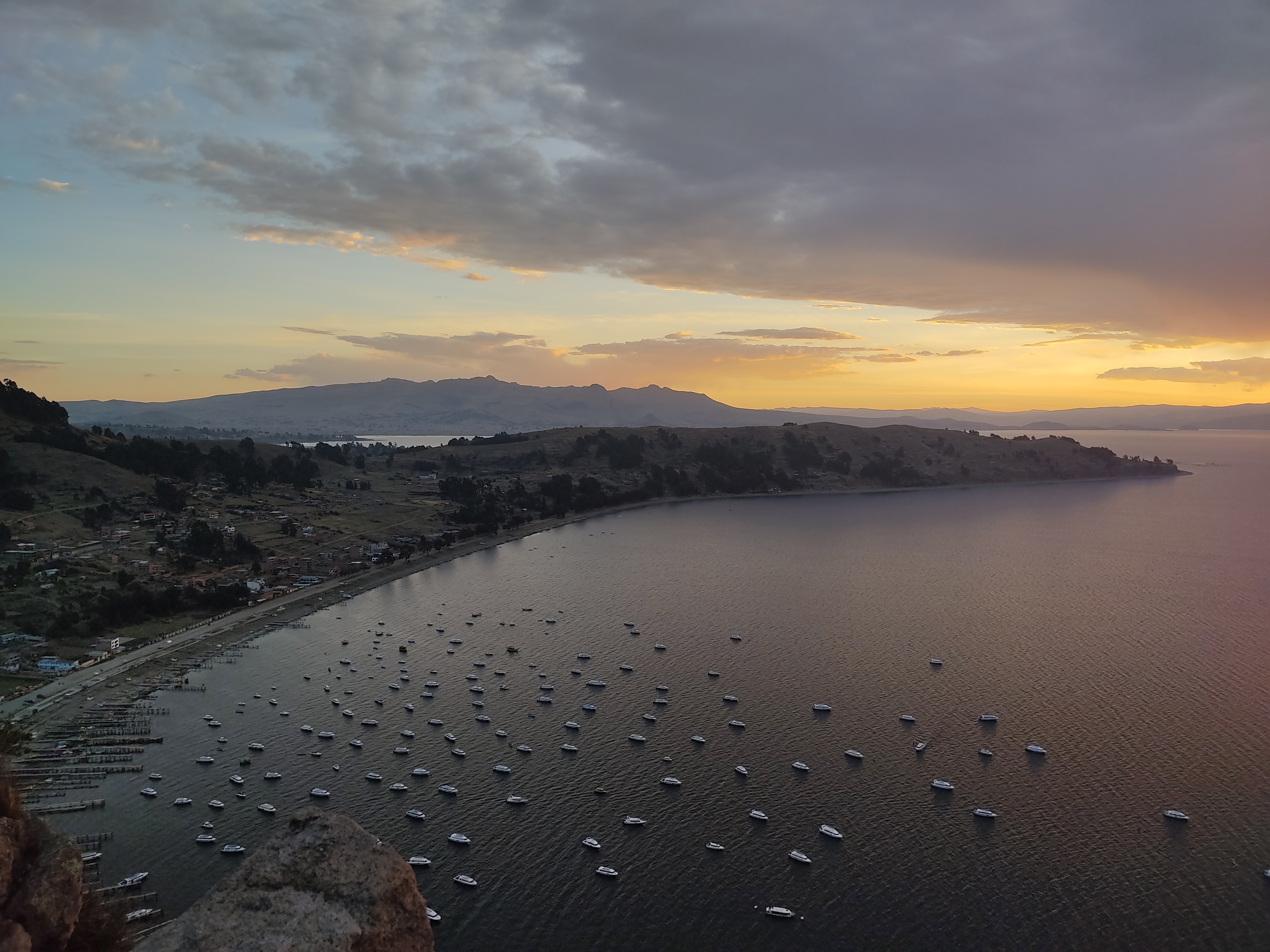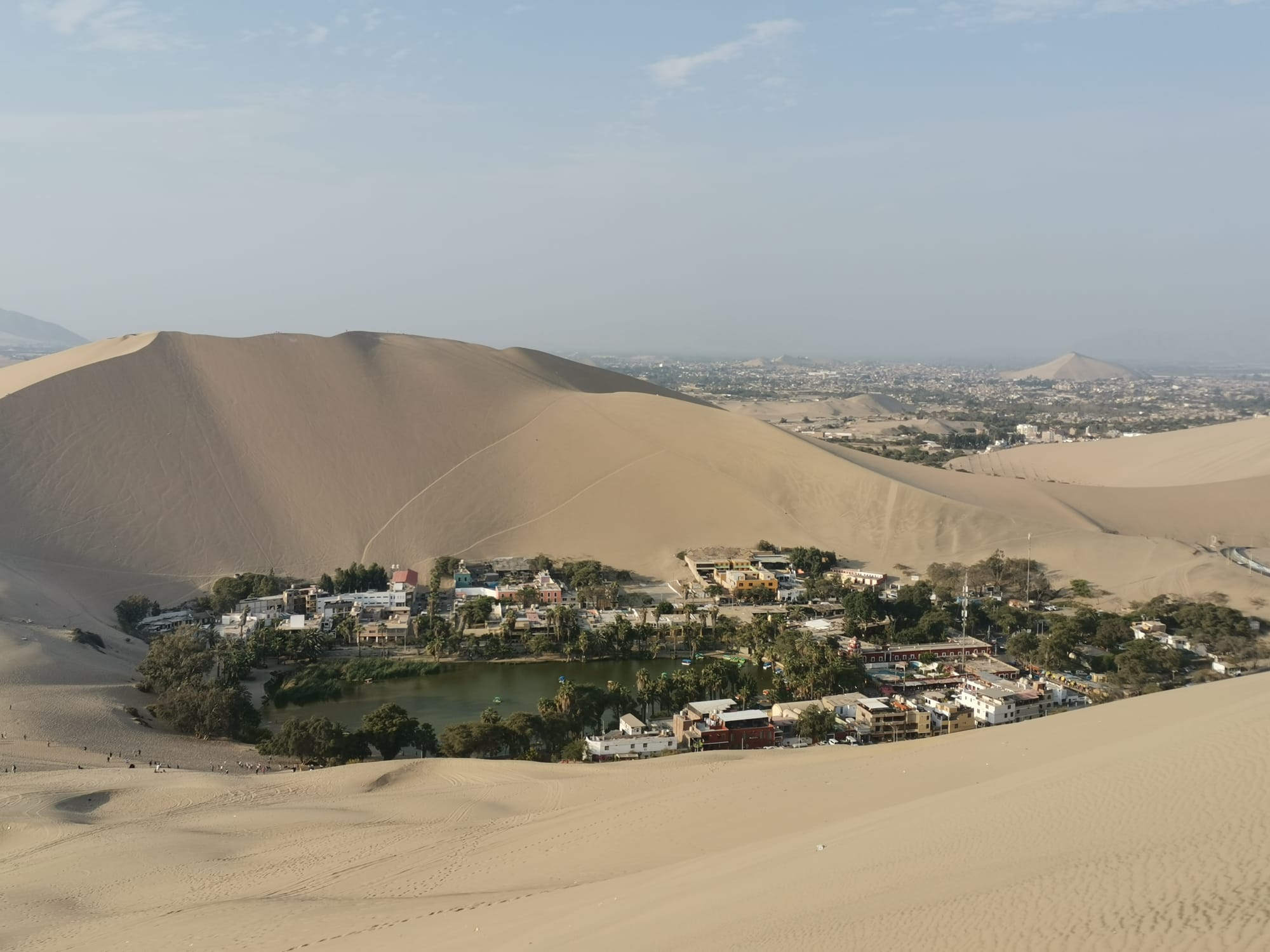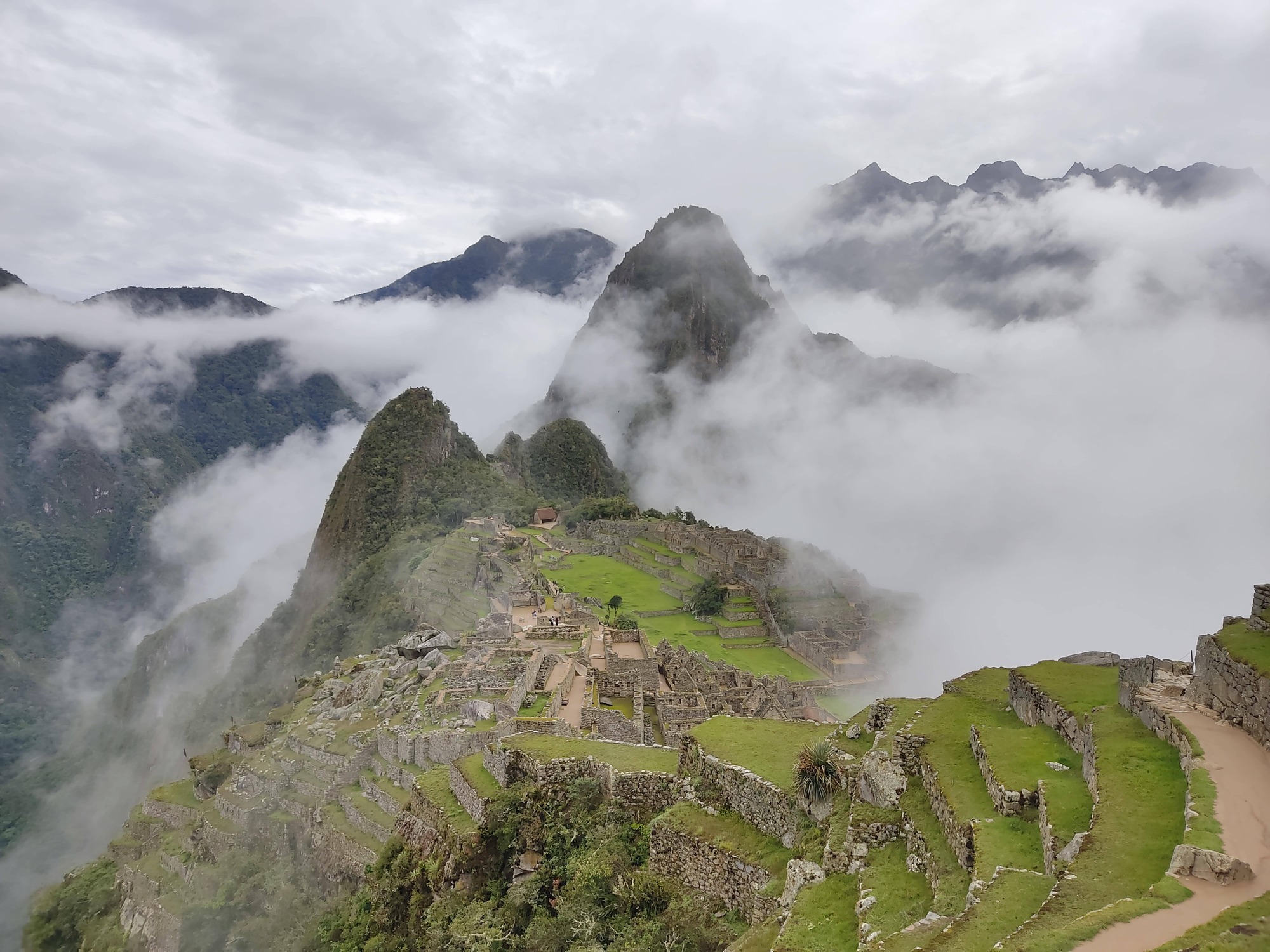Introduction
We decided to start our South American backpacking journey in Peru because of the timing of our trip. October is a shoulder season in Peru and so we hoped would this would be the perfect time to visit. Peru turned out to be an incredible place to begin our journey, full of quintessential South American culture and traditions, out of this World landscapes, and good tourist infrastructure, which ensured our first month on the road went smoothly. The cities were full of bustling markets and relaxing plazas, with women pushing wagons of freshly-pressed orange juice and homemade cakes, and farmers parading their alpacas around in the hopes that tourists will offer a donation in exchange for a cute photo. The rural areas were home to small, traditional communities, ancient incan temples, colourful mountains and tranquil canyons. We clearly aren't alone in our love of Peru, because even in the low-season, the places we saw were full of tourists, so it clearly is no secret that Peru is a top destination to be seen.
Our Route through Peru
Our route through Peru.Hover over places of interest to reveal more. Click the popups to jump to the relevant section
Lima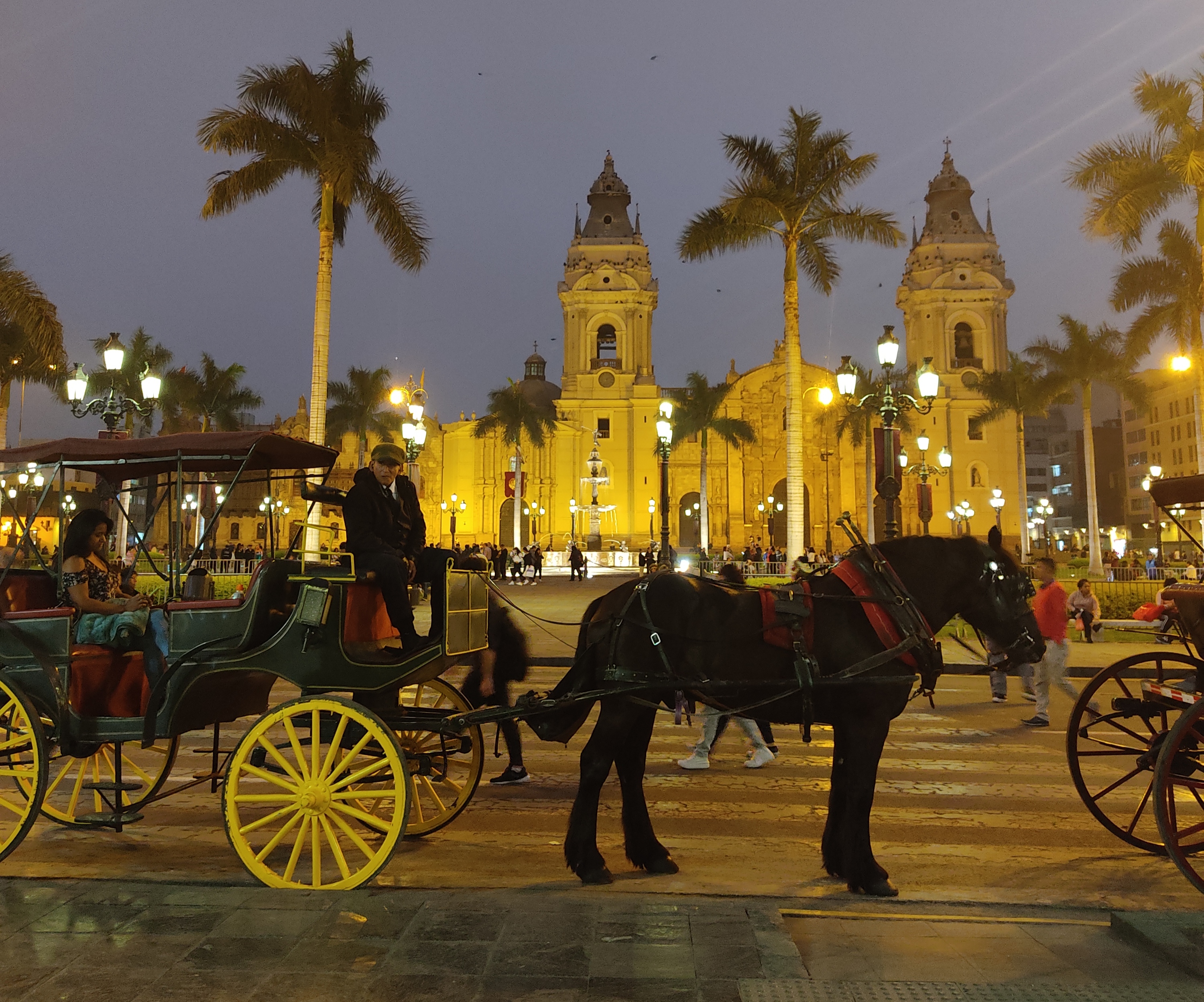 Our first steps in South America were in Lima, one of its biggest cities. Lima is a sprawling metropolis, with plenty going on to keep you busy for a few days.
Huacachina
Our first steps in South America were in Lima, one of its biggest cities. Lima is a sprawling metropolis, with plenty going on to keep you busy for a few days.
Huacachina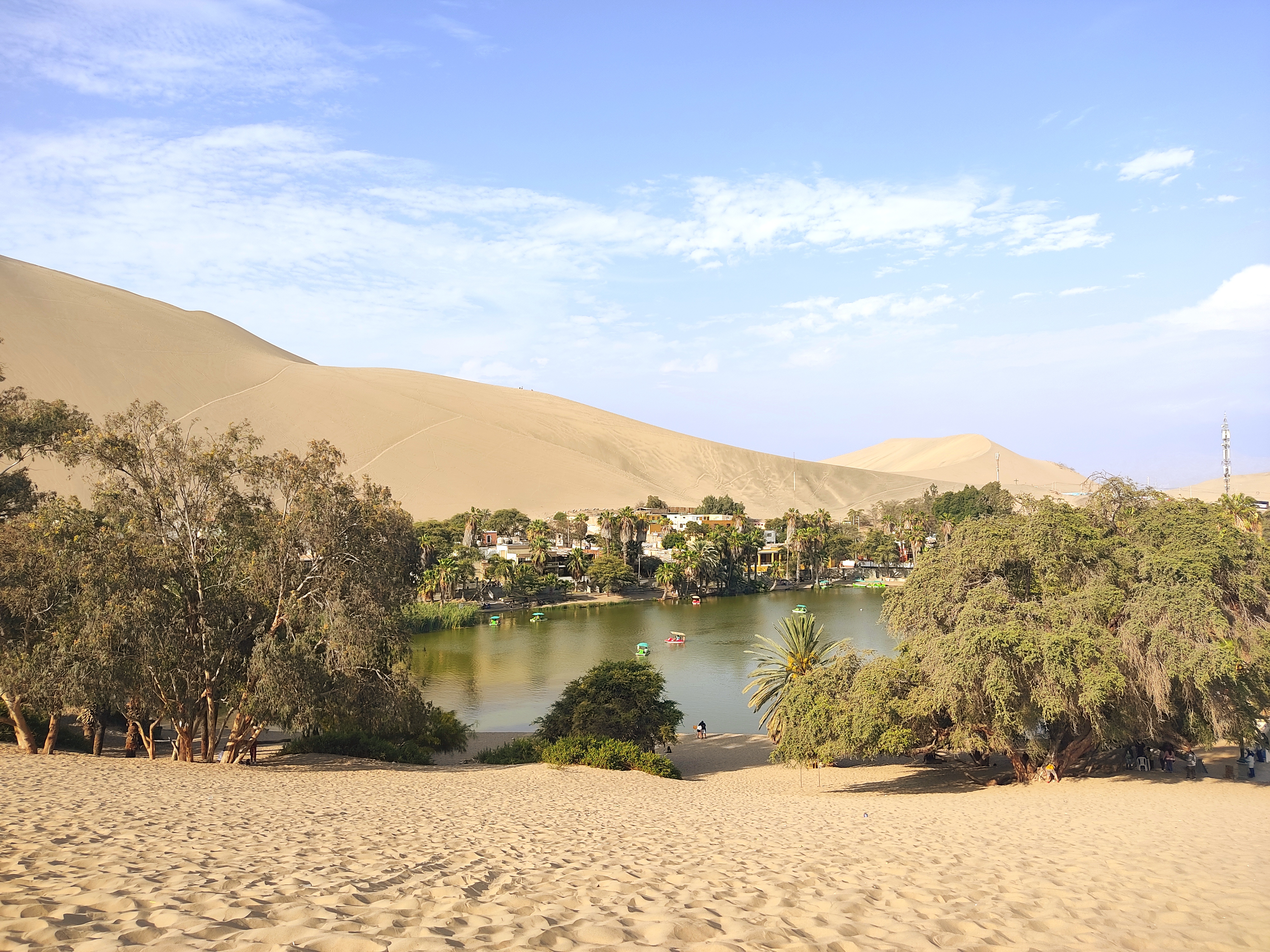 Only a short distance from Paracas, the desert oasis of Huacachina was a unique spot to relax and enjoy the sunshine.
Paracas
Only a short distance from Paracas, the desert oasis of Huacachina was a unique spot to relax and enjoy the sunshine.
Paracas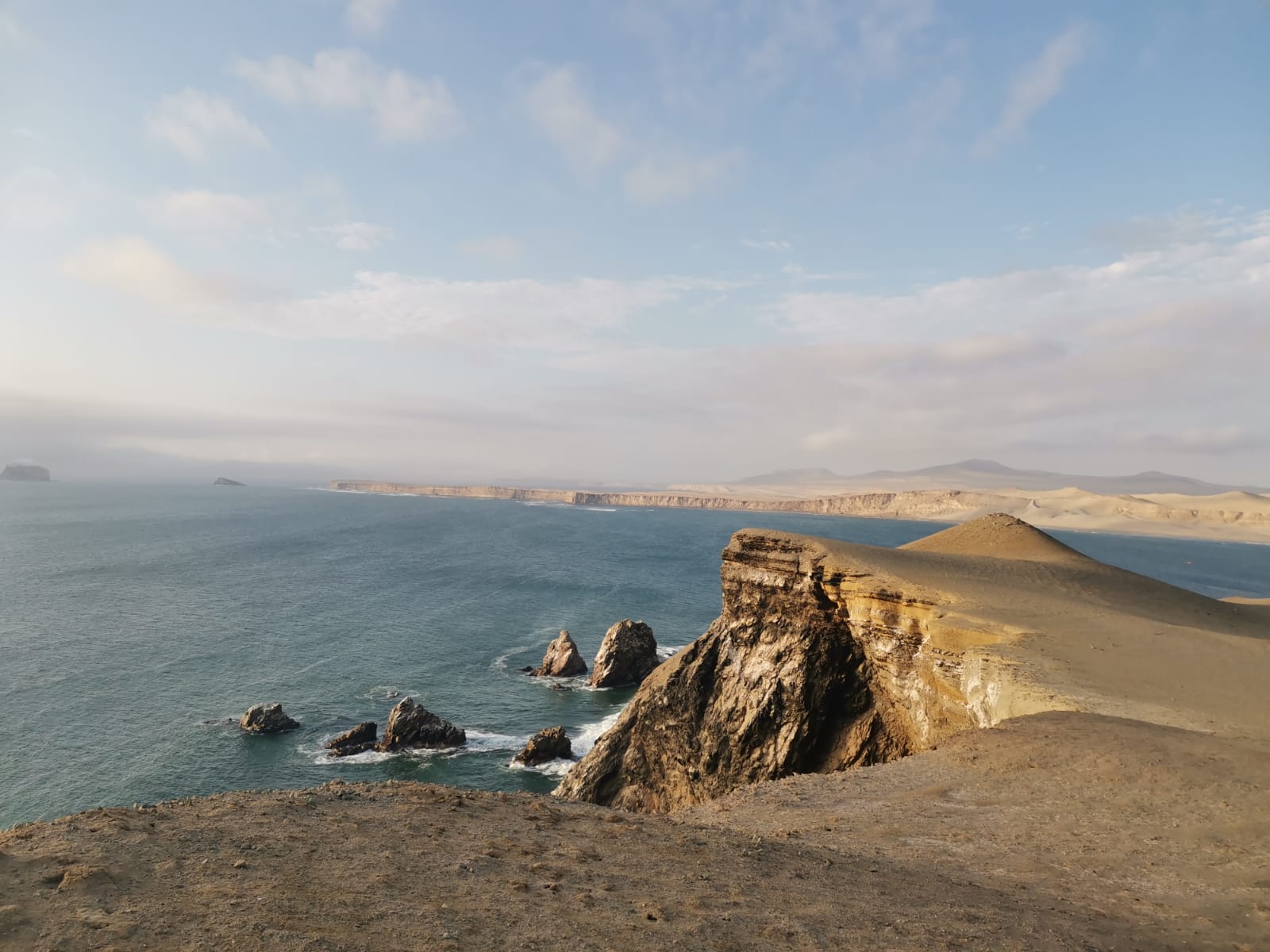 We took the slow route from Lima, making our first stop in the coastal town of Paracas, home to a nature reserve and lots of dramatic desert scenery.
Nasca
We took the slow route from Lima, making our first stop in the coastal town of Paracas, home to a nature reserve and lots of dramatic desert scenery.
Nasca Also in the desert, Nasca is famous for the 'Nasca Lines' - giant markings in the sand which were created hundreds of years ago. To this day, no-one knows why or how they were constructed.
Arequipa
Also in the desert, Nasca is famous for the 'Nasca Lines' - giant markings in the sand which were created hundreds of years ago. To this day, no-one knows why or how they were constructed.
Arequipa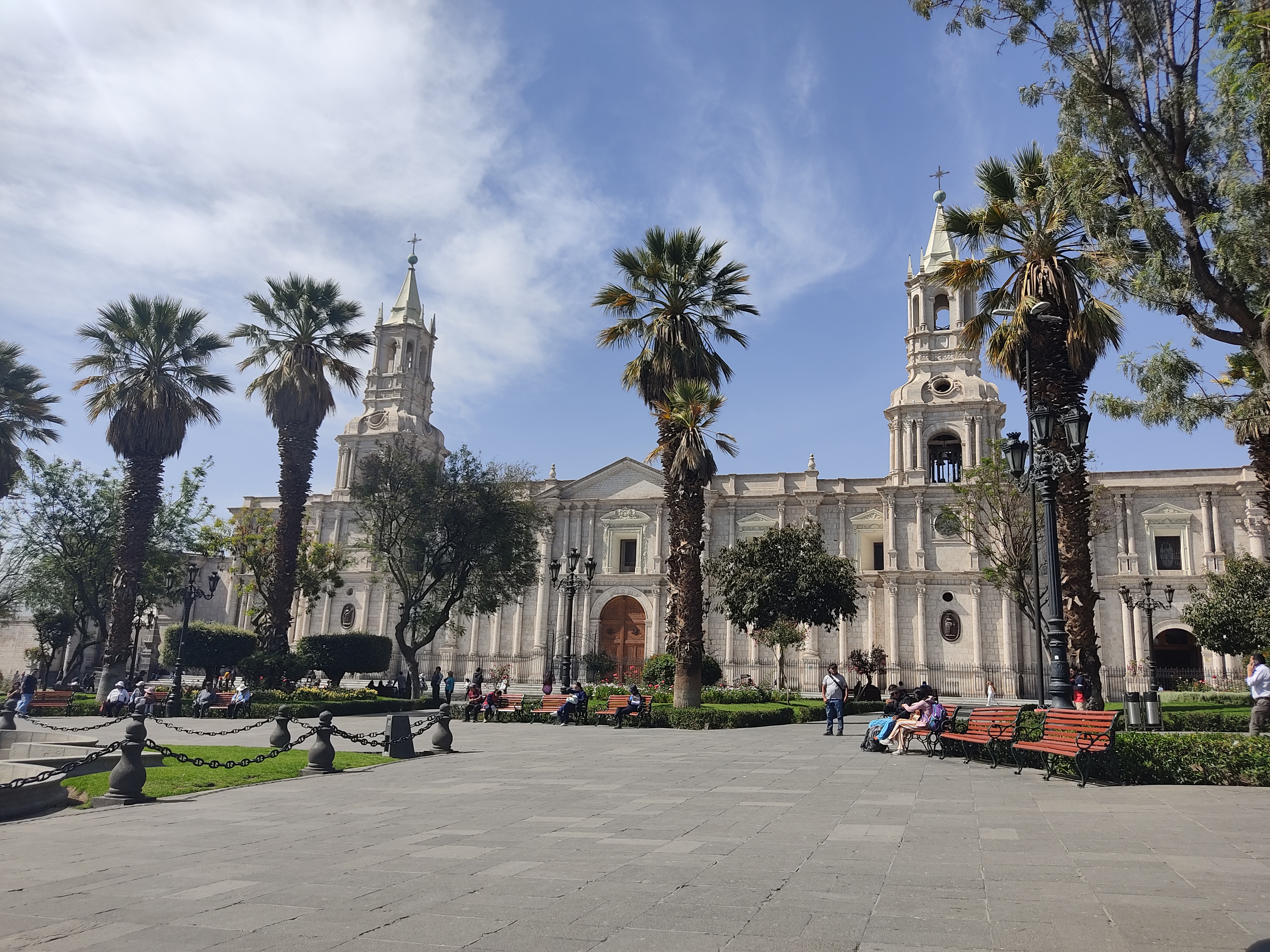 As we begin to climb into the Andes, we will stop at Arequipa to acclimatise to the altitude. This is a popular town, with many excursions including hikes and wildlife spotting.
Cusco
As we begin to climb into the Andes, we will stop at Arequipa to acclimatise to the altitude. This is a popular town, with many excursions including hikes and wildlife spotting.
Cusco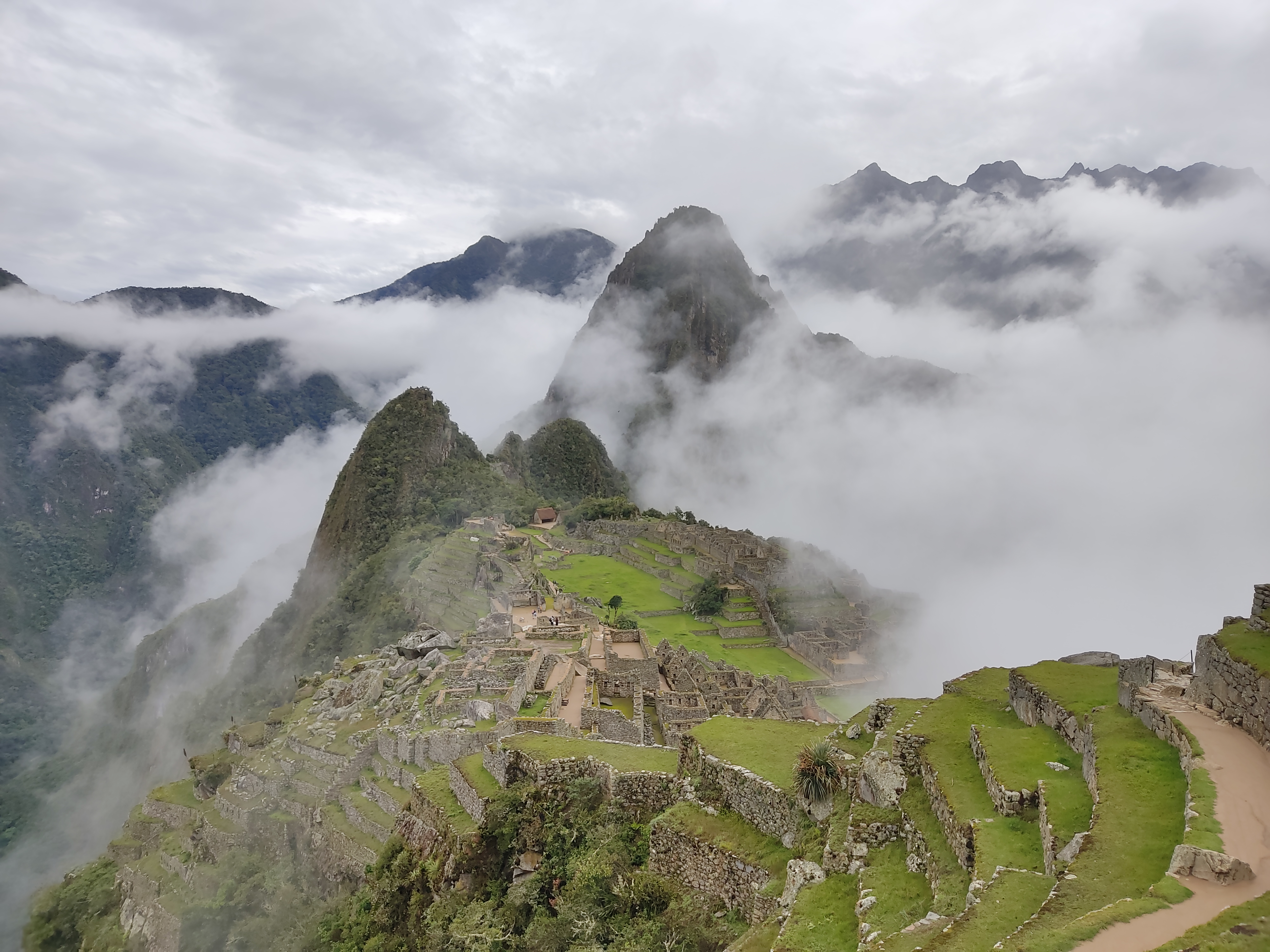 Cusco is probably the most visited city in Peru. Famous for being the starting point for all tours along the Inca Trail to Machu Picchu.
Puno
Cusco is probably the most visited city in Peru. Famous for being the starting point for all tours along the Inca Trail to Machu Picchu.
Puno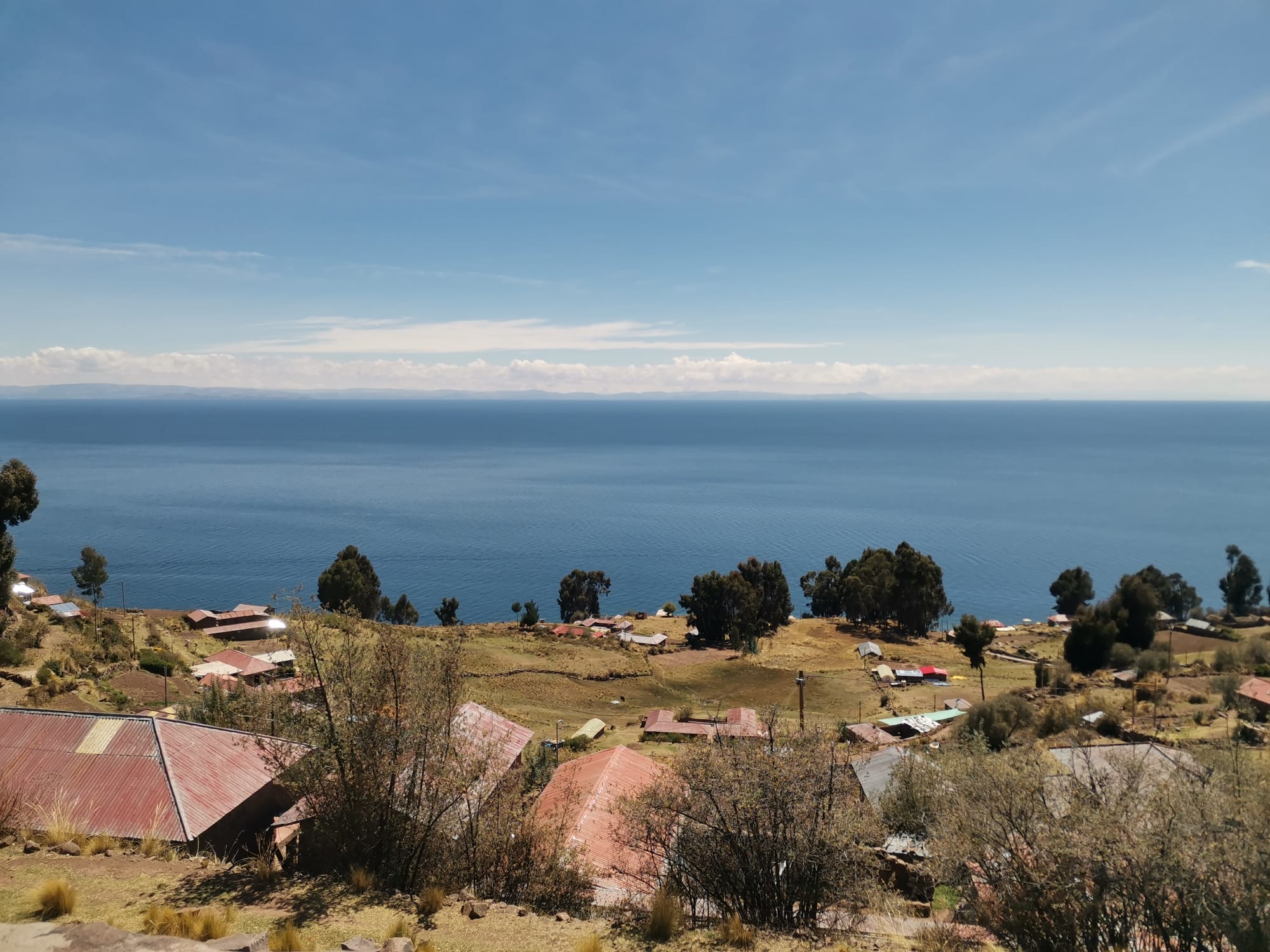 On the shores of lake Titicaca, Puno is our final destination in Peru, before we continue on into Bolivia.
On the shores of lake Titicaca, Puno is our final destination in Peru, before we continue on into Bolivia.
Lima
The first destination on our very long South American itinerary was Lima, the capital and largest city in Peru. Although it is often considered merely as a short stop en-route to the more famous tourist attractions in Peru, Lima and the surrounding regions have plenty to offer for those willing to spend a little time exploring. Although home to 11 million people, Lima prides itself on being an incredibly clean and calm city. Its dramatic setting atop cliffs overlooking the Pacific Ocean provide an imposing cityscape.
Aside from a bold and peaceful historic centreLima's historic centre.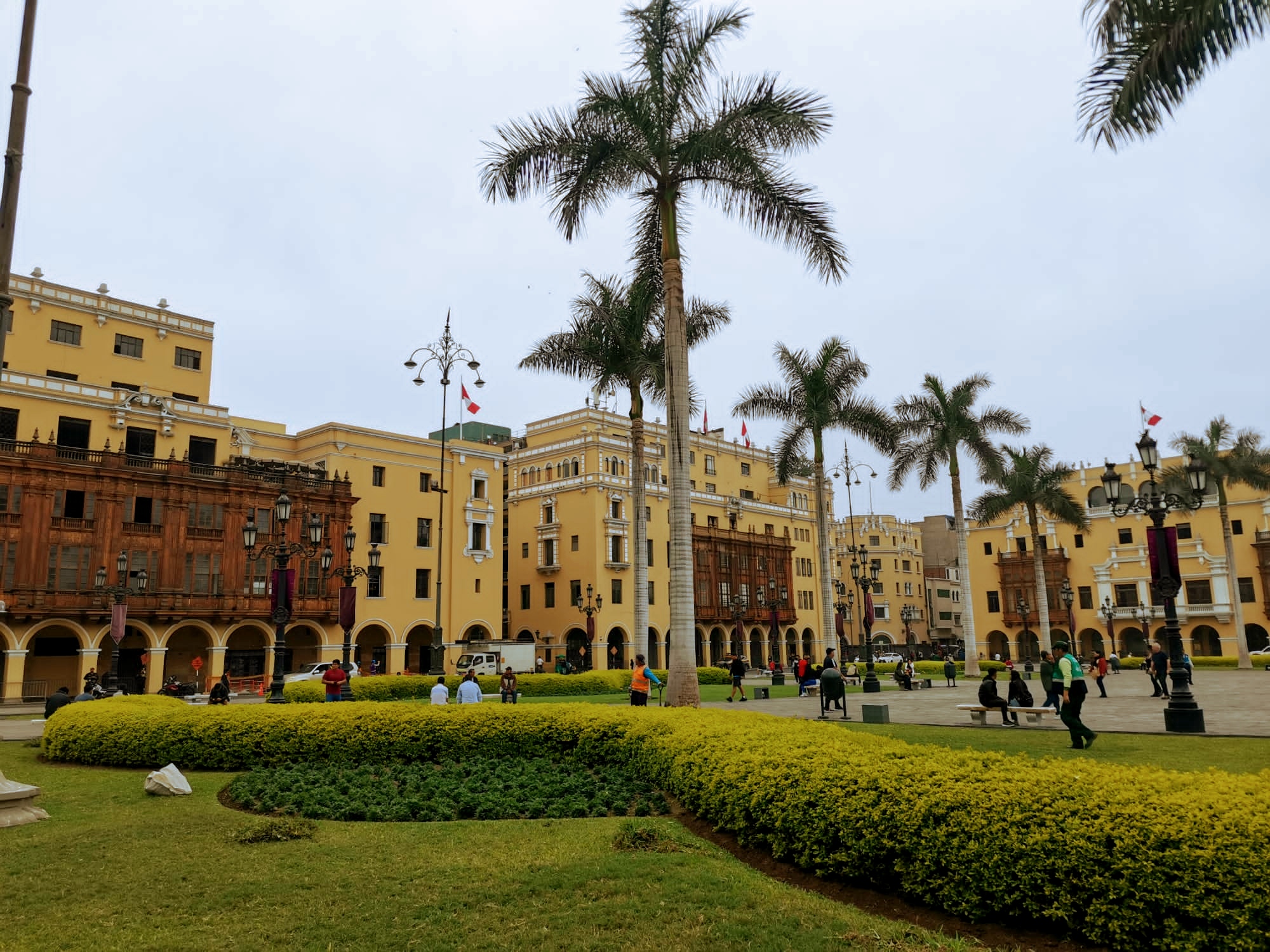 The centre of Lima is full of UNESCO World heritage buildings, and was much quiter and calmer than most other city centers. and colourful BarrancoBarranco
The centre of Lima is full of UNESCO World heritage buildings, and was much quiter and calmer than most other city centers. and colourful BarrancoBarranco Barranco is one of the main tourist neighbourhoods in Lima. Although it is quite far from the center, it has loads of hostels, bars, restaurants, and cafes., one of the best places to visit is Miraflores, home to the cat parkCat Park
Barranco is one of the main tourist neighbourhoods in Lima. Although it is quite far from the center, it has loads of hostels, bars, restaurants, and cafes., one of the best places to visit is Miraflores, home to the cat parkCat Park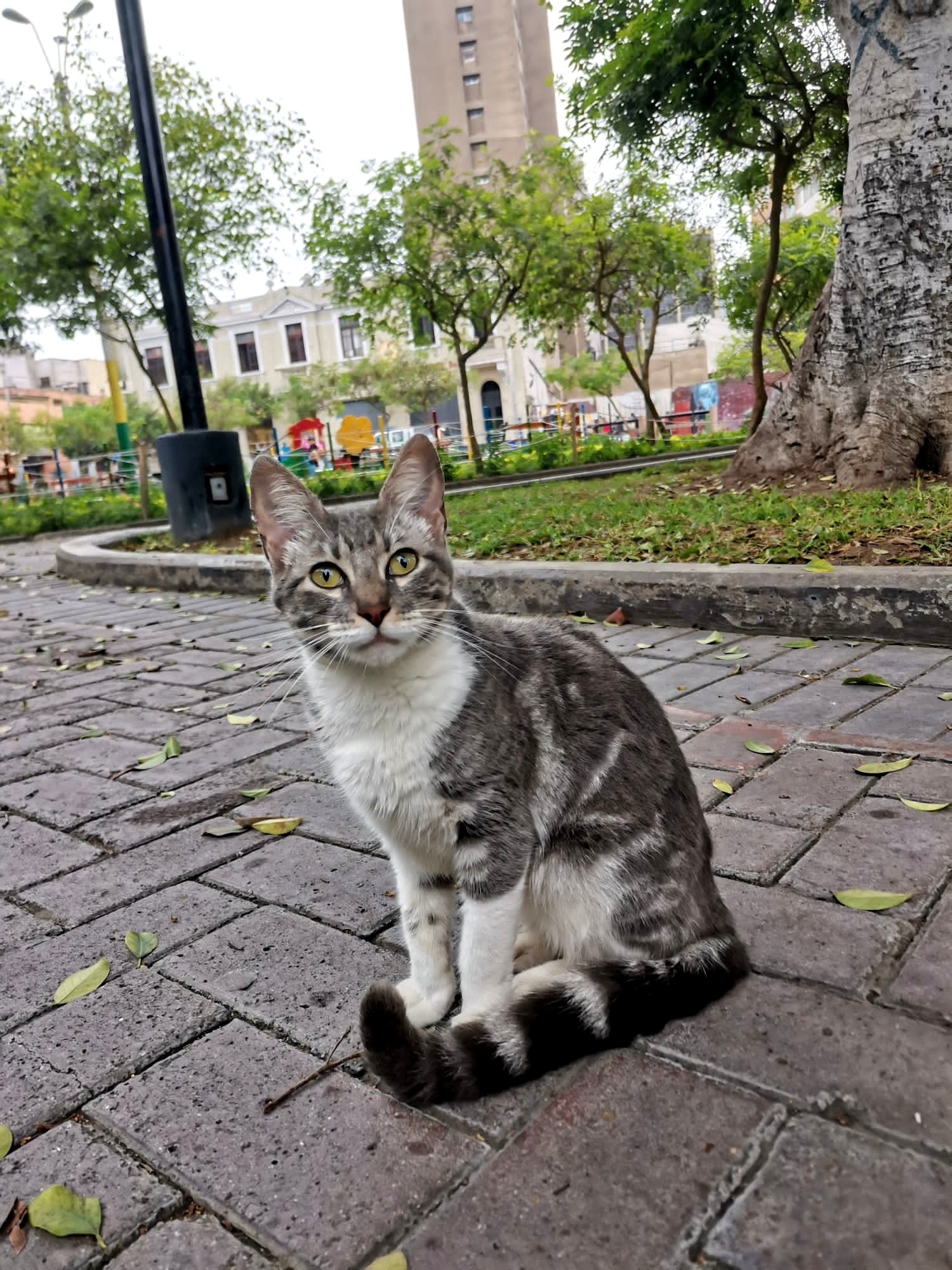 Parque Kennedy is no regular city park. Home to a large population of cats, which are technically strays but have food, water, and beds provided, this is the best place to sit and relax if you are a cat lover. Be sure to look up as you walk through - the cats like hiding in the trees., Huaca PucllanaHuaca Pucllana
Parque Kennedy is no regular city park. Home to a large population of cats, which are technically strays but have food, water, and beds provided, this is the best place to sit and relax if you are a cat lover. Be sure to look up as you walk through - the cats like hiding in the trees., Huaca PucllanaHuaca Pucllana 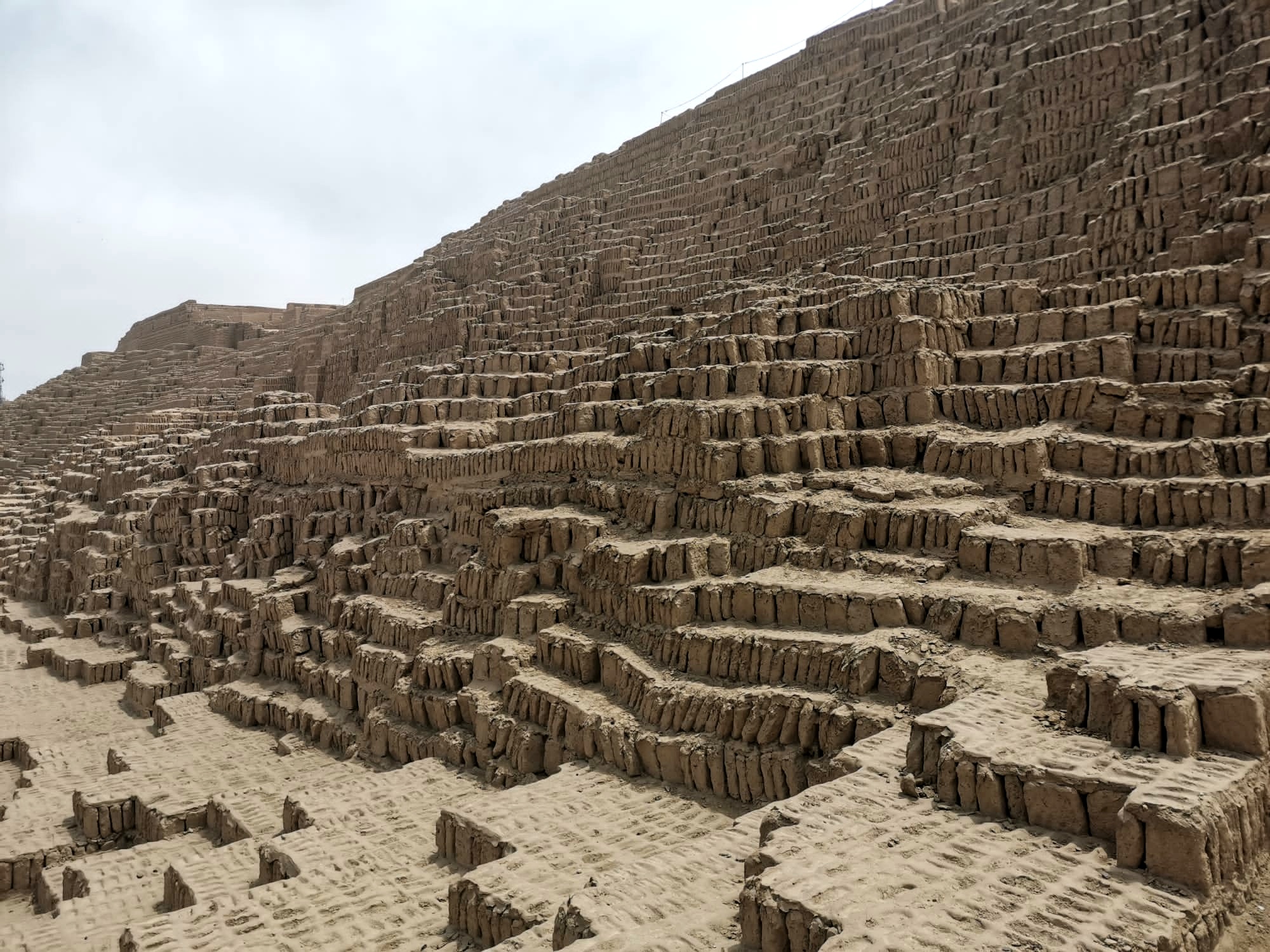 Huaca Pucllana is essentially an open-air museum, where you can visit an ancient archaeological site. This pyramid-like structure was built over 2000 years ago, and has lasted so long due to its earthquake-proof architecture and the incredibly low annual rainfall in Lima., the MelaconThe Melacon is a coastal walkway along the cliffs of Miraflores, providing an incredible view of both the Ocean and the city. It is also home to many small parks to relax., and the unique LarcomarThis bougie shopping centre spans 3 floors, built down into the cliff face overlooking the ocean. As well as being an architectural marvel, it also has a statue of Paddington bear on the top floor for a reminder of home! shopping centre. In case that doesn't seem like enough to keep you occupied, Lima has a few more daring excursions on offer. You can visit the Palominos islandsPalominos Islands
Huaca Pucllana is essentially an open-air museum, where you can visit an ancient archaeological site. This pyramid-like structure was built over 2000 years ago, and has lasted so long due to its earthquake-proof architecture and the incredibly low annual rainfall in Lima., the MelaconThe Melacon is a coastal walkway along the cliffs of Miraflores, providing an incredible view of both the Ocean and the city. It is also home to many small parks to relax., and the unique LarcomarThis bougie shopping centre spans 3 floors, built down into the cliff face overlooking the ocean. As well as being an architectural marvel, it also has a statue of Paddington bear on the top floor for a reminder of home! shopping centre. In case that doesn't seem like enough to keep you occupied, Lima has a few more daring excursions on offer. You can visit the Palominos islandsPalominos Islands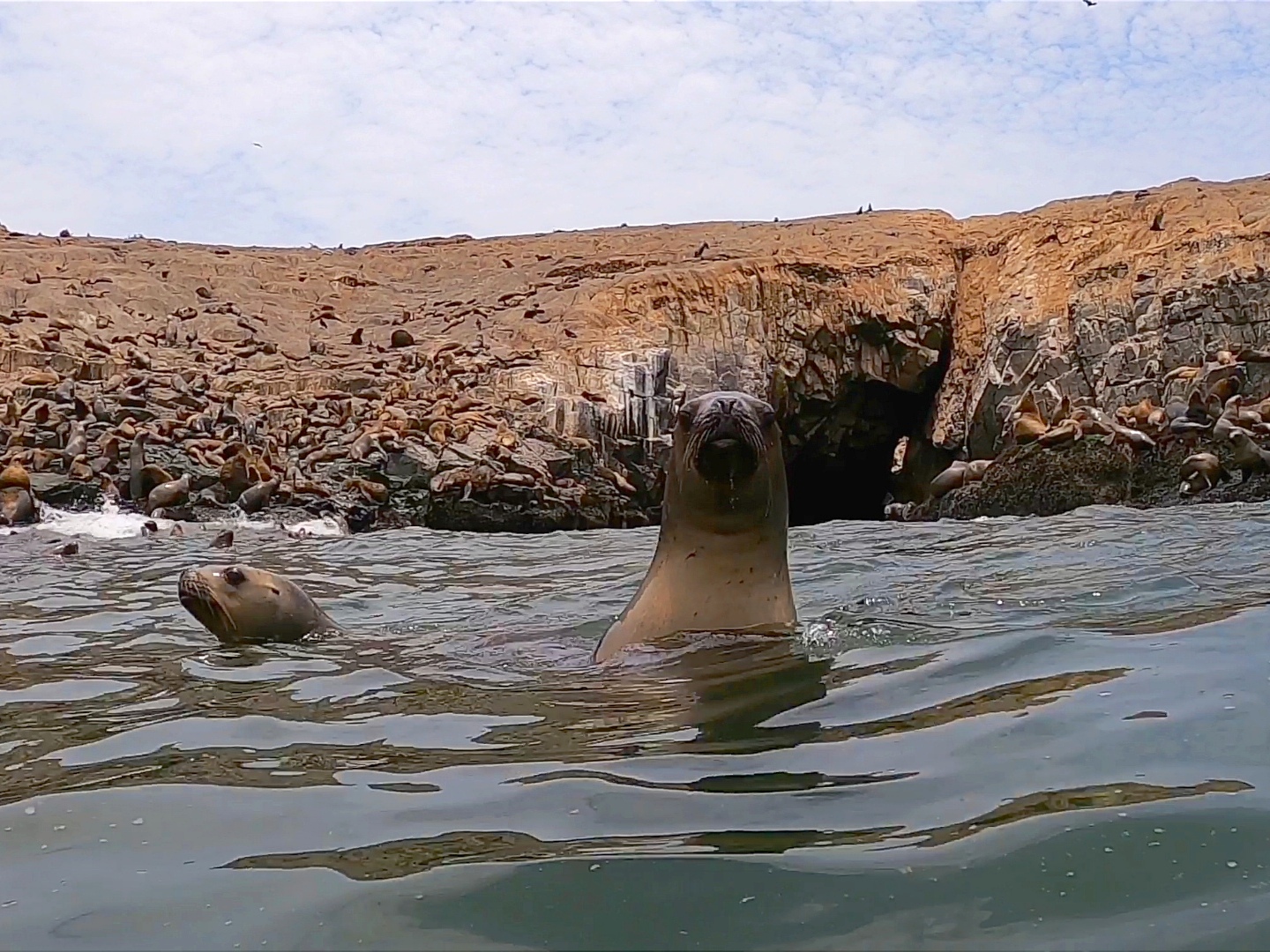 The Palominos islands are one of the few natute reserves where you can actually jump into the ocean and swim with the thousands of sea lions that live there. The younger sea lions are curious and playful, and swim right up to tourists to check them out. to go swimming with sea lions, or go paraglidingParagliding
The Palominos islands are one of the few natute reserves where you can actually jump into the ocean and swim with the thousands of sea lions that live there. The younger sea lions are curious and playful, and swim right up to tourists to check them out. to go swimming with sea lions, or go paraglidingParagliding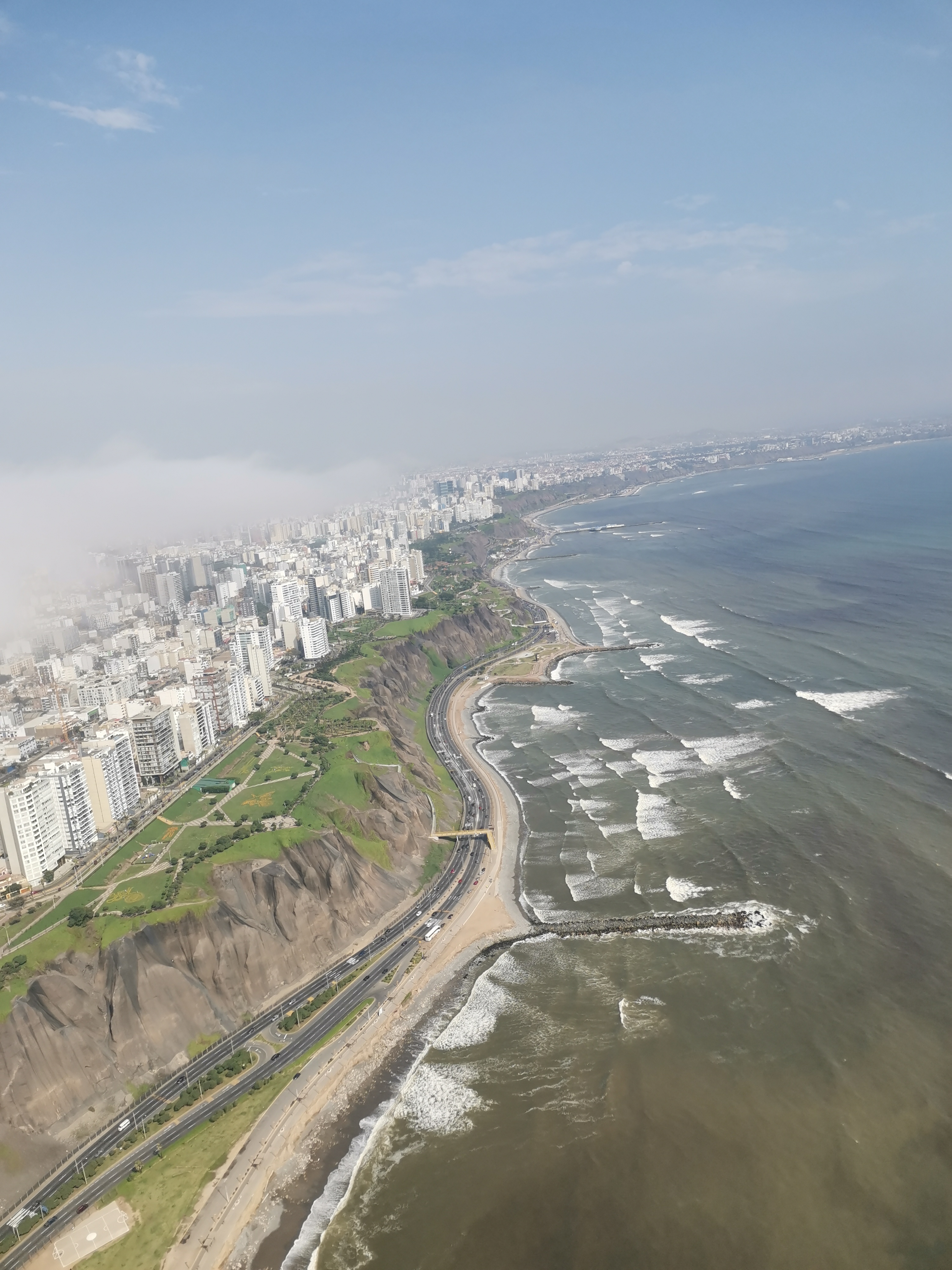 Paragliding along the coast is one of the more exhilarating acticites you can do in Lima. The tall cliffs and coastal breeze makes this one of the best spots in the world to paraglide, and the view of the city is unbeatable. over Lima's cliffs.
Paragliding along the coast is one of the more exhilarating acticites you can do in Lima. The tall cliffs and coastal breeze makes this one of the best spots in the world to paraglide, and the view of the city is unbeatable. over Lima's cliffs.
The Road to Cusco
Only 2hrs South of Lima, the small town of ParacasParacas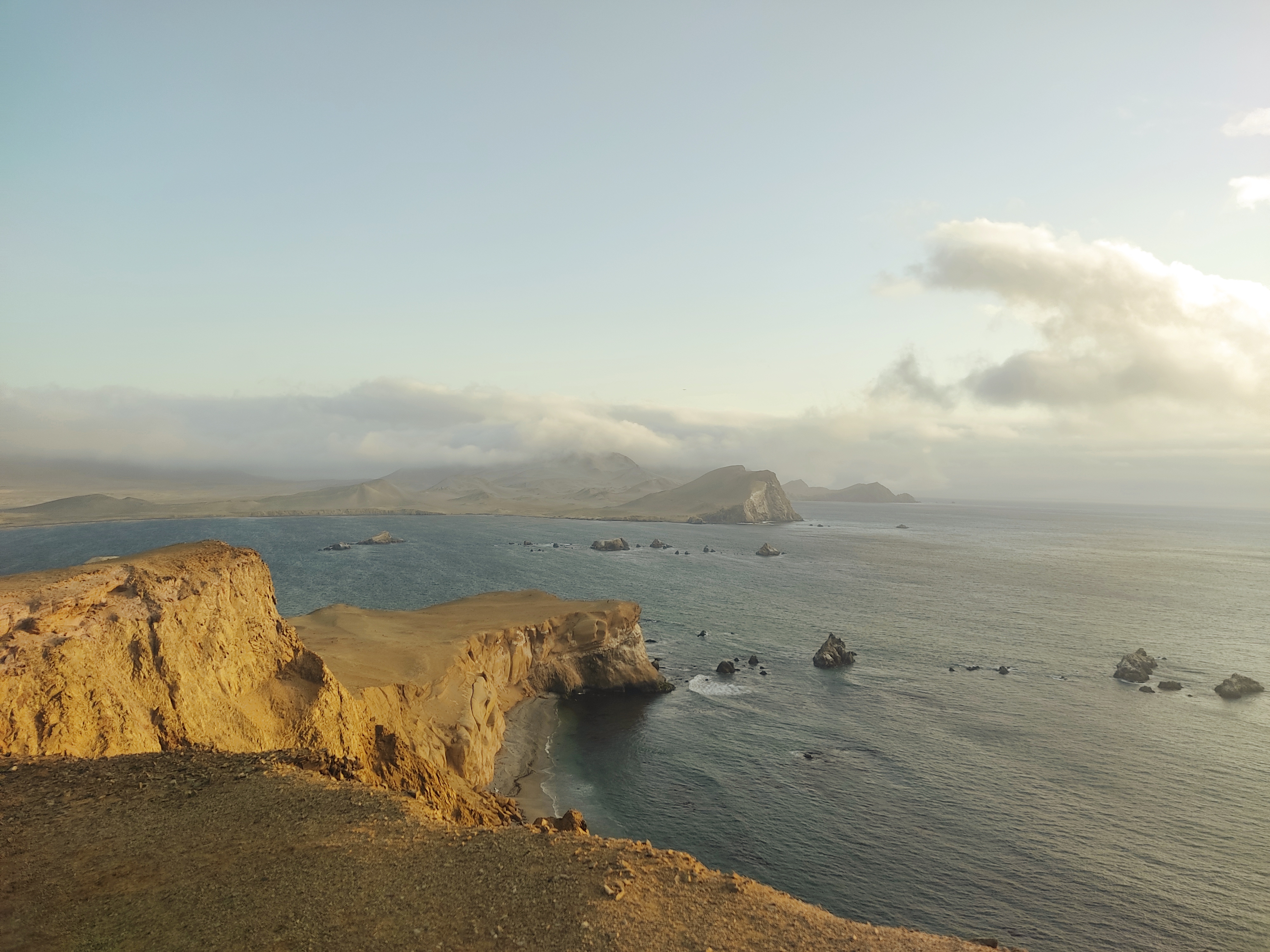 The Paracas national reserve is a vast, barren, and rugged area, home to flamingoes, vultures, and pelicans. Its red beaches and rocky plains feel like they belong to another planet. is packed with tourists looking to escape to see some of the Peruvian nature and landscapes. Next to Paracas, the increasingly-popular Huacachina OasisHuacachina
The Paracas national reserve is a vast, barren, and rugged area, home to flamingoes, vultures, and pelicans. Its red beaches and rocky plains feel like they belong to another planet. is packed with tourists looking to escape to see some of the Peruvian nature and landscapes. Next to Paracas, the increasingly-popular Huacachina OasisHuacachina Surrounded by the towering dunes of the Atacama, this small oasis has to be seen to be believed. A lush, tropical paradise in an otherwise hostile desert creates a mesmerising contrast, and there is surely no other place on earth quite like it. is waiting to be discovered. Climb the slopes to get an unbeatable view of the mystic desert oasis, or fly down the giant sand dunes face-first on a sandboard. Further south, the town of NascaThe Nasca Lines
Surrounded by the towering dunes of the Atacama, this small oasis has to be seen to be believed. A lush, tropical paradise in an otherwise hostile desert creates a mesmerising contrast, and there is surely no other place on earth quite like it. is waiting to be discovered. Climb the slopes to get an unbeatable view of the mystic desert oasis, or fly down the giant sand dunes face-first on a sandboard. Further south, the town of NascaThe Nasca Lines Nasca is a small town, and is only on the tourist circuit because of its ancient geoglyphs written in the sand. Having withstood 2000 years in the desert, archaeologists are now pondering over the significance of these sites. is known worldwide for its geoglyphs. These ancient drawings in the sand have been incredibly well preserved for almost 2,000 years, and there are many theories as to what their significance was. Finally, no trip to the south of Peru would be complete without spending at least a few days in Arequipa,Arequipa
Nasca is a small town, and is only on the tourist circuit because of its ancient geoglyphs written in the sand. Having withstood 2000 years in the desert, archaeologists are now pondering over the significance of these sites. is known worldwide for its geoglyphs. These ancient drawings in the sand have been incredibly well preserved for almost 2,000 years, and there are many theories as to what their significance was. Finally, no trip to the south of Peru would be complete without spending at least a few days in Arequipa,Arequipa Wherever you are in Areauipa, you are surrounded by beautiful architecture and stunning landscapes. From the best viewpoints, you can see both the town and the 3 volcanoes which dominate the horizon. Peru's white city known for having some of the most stunning architecture in the whole country. From an impressive plaza to the bold Santa Catalina monasterySanta Catalina Monastery
Wherever you are in Areauipa, you are surrounded by beautiful architecture and stunning landscapes. From the best viewpoints, you can see both the town and the 3 volcanoes which dominate the horizon. Peru's white city known for having some of the most stunning architecture in the whole country. From an impressive plaza to the bold Santa Catalina monasterySanta Catalina Monastery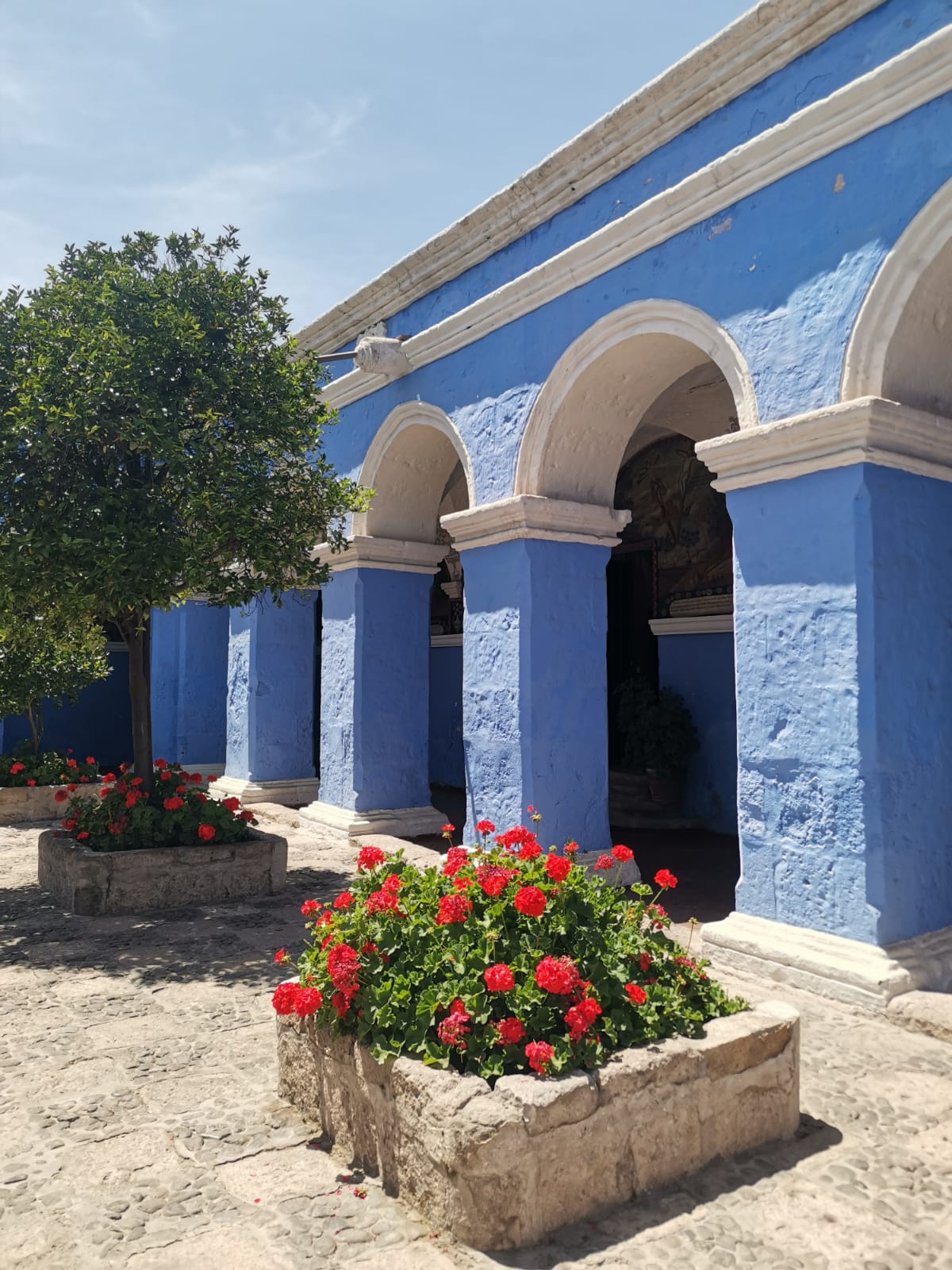 The Santa Catalina monastery is often called a 'town within a town', due to its size. Inside its walls is a maze of narrow streets and courtyards, all painted in vibrant colours. The monastery is incredibly quiet and peaceful, almost to the extent of becoming eerie, and it would be easy to get lost wihtout the signposts pointing out the exit., Arequipa is full of photogenic streets and breathtaking viewpoints.
The Santa Catalina monastery is often called a 'town within a town', due to its size. Inside its walls is a maze of narrow streets and courtyards, all painted in vibrant colours. The monastery is incredibly quiet and peaceful, almost to the extent of becoming eerie, and it would be easy to get lost wihtout the signposts pointing out the exit., Arequipa is full of photogenic streets and breathtaking viewpoints.
The Colca Canyon
A visit to Arequipa not only allows you to experience the incredible Peruvian city, but also provides an opportunity to see some of Peru's stunning landscapes. The Colca Canyon, the World's 2nd deepest canyon, is just a few hours drive from Arequipa and is a popular tourist spot by day. However, if you choose to stay the night, you can sleep in one of the most remote places in Peru and it will feel like the whole canyon is yours to explore.
Cusco
Many people who visit Peru just see Cusco. Although most famous for Machu PicchuMachu Picchu Machu Picchu, one of the seven wonders of the World, is the most famous attraction in Peru. Hundreds of years old, this suprisingly well-preserved Incan city is perched atop a mountain and surrounded by a sea of clouds, giving it a fairy-tale feel., Cusco has countless adventures to offer any type of tourist. The city itself contains subtle reminders of the Inca civilization, with the current structures constructed from a blend of Incan and colonial architecture. You can spend hours wandering around the city, getting lost in its narrow labyrinth of ancient streets and alleyways. Beyond the city, you can embark on a range of day hikes to see unique natural landscapes such as rainbow mountainRainbow Mountain
Machu Picchu, one of the seven wonders of the World, is the most famous attraction in Peru. Hundreds of years old, this suprisingly well-preserved Incan city is perched atop a mountain and surrounded by a sea of clouds, giving it a fairy-tale feel., Cusco has countless adventures to offer any type of tourist. The city itself contains subtle reminders of the Inca civilization, with the current structures constructed from a blend of Incan and colonial architecture. You can spend hours wandering around the city, getting lost in its narrow labyrinth of ancient streets and alleyways. Beyond the city, you can embark on a range of day hikes to see unique natural landscapes such as rainbow mountainRainbow Mountain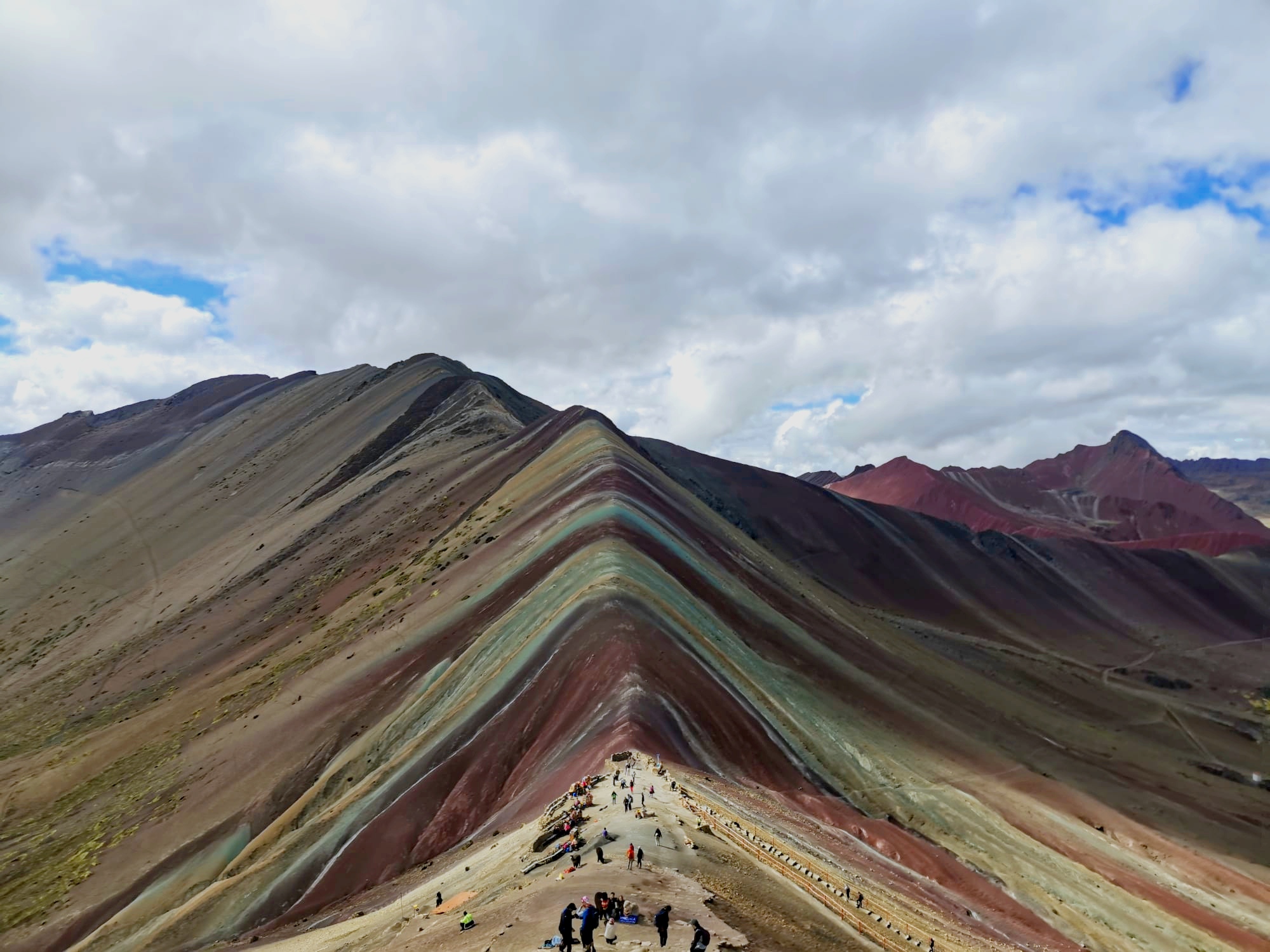 Rainbow Mountain has become a popular tourist attraction outside of Cusco. Hiking up to over 5,000m above sea level is well worth the effort to see these multicoloured stripes on this iconic mountain. or Humantay lakeHumantay lake
Rainbow Mountain has become a popular tourist attraction outside of Cusco. Hiking up to over 5,000m above sea level is well worth the effort to see these multicoloured stripes on this iconic mountain. or Humantay lakeHumantay lake 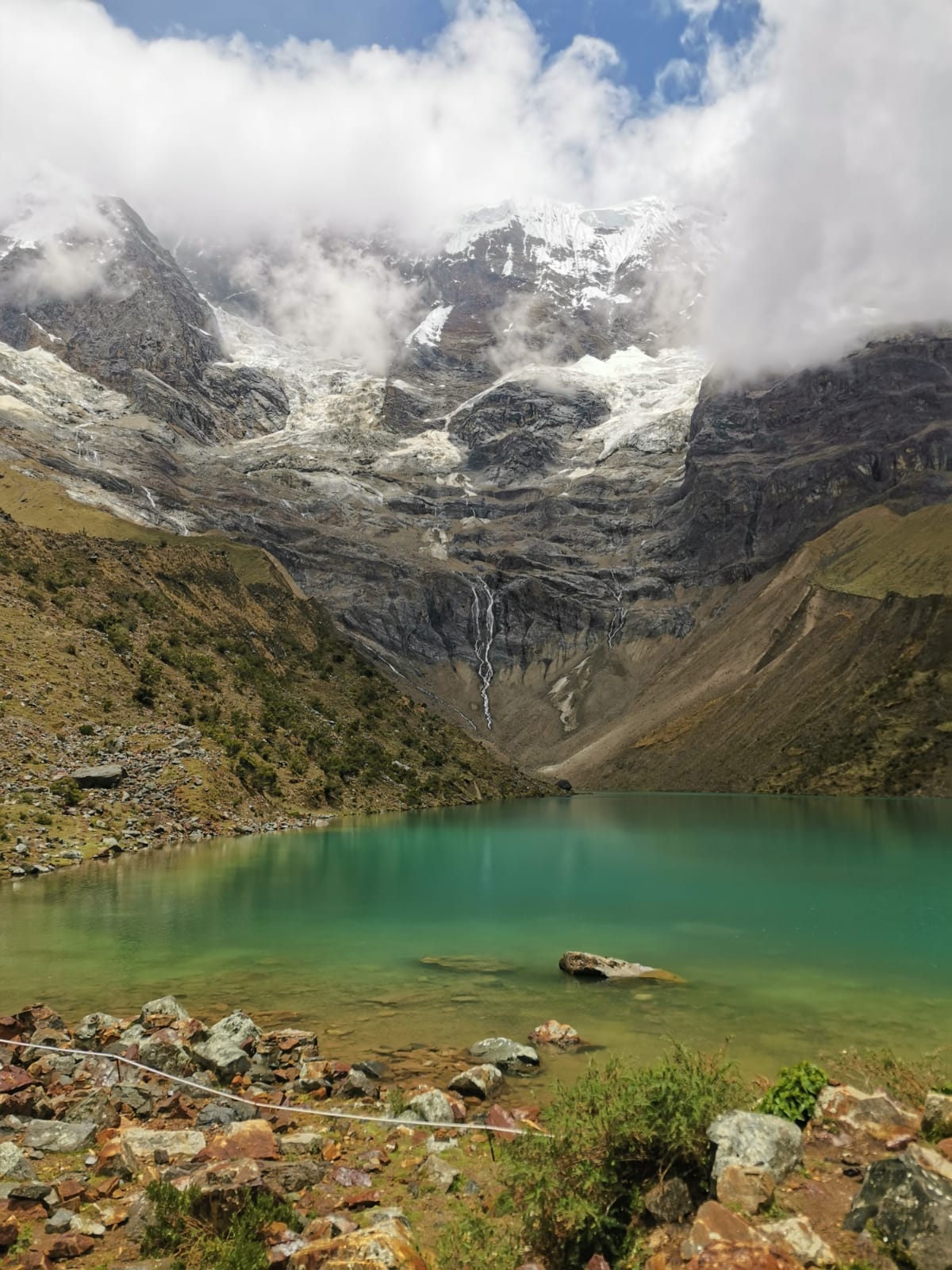 Humantay lake can be reached via a day tour from Cusco, followed by a steep uphill trek. The view from the lake is mesmerising, with green valleys and icy mountains flanking the impossibly-blue lake., visit traditional towns in the sacred valley, and explore Incan ruins
Humantay lake can be reached via a day tour from Cusco, followed by a steep uphill trek. The view from the lake is mesmerising, with green valleys and icy mountains flanking the impossibly-blue lake., visit traditional towns in the sacred valley, and explore Incan ruins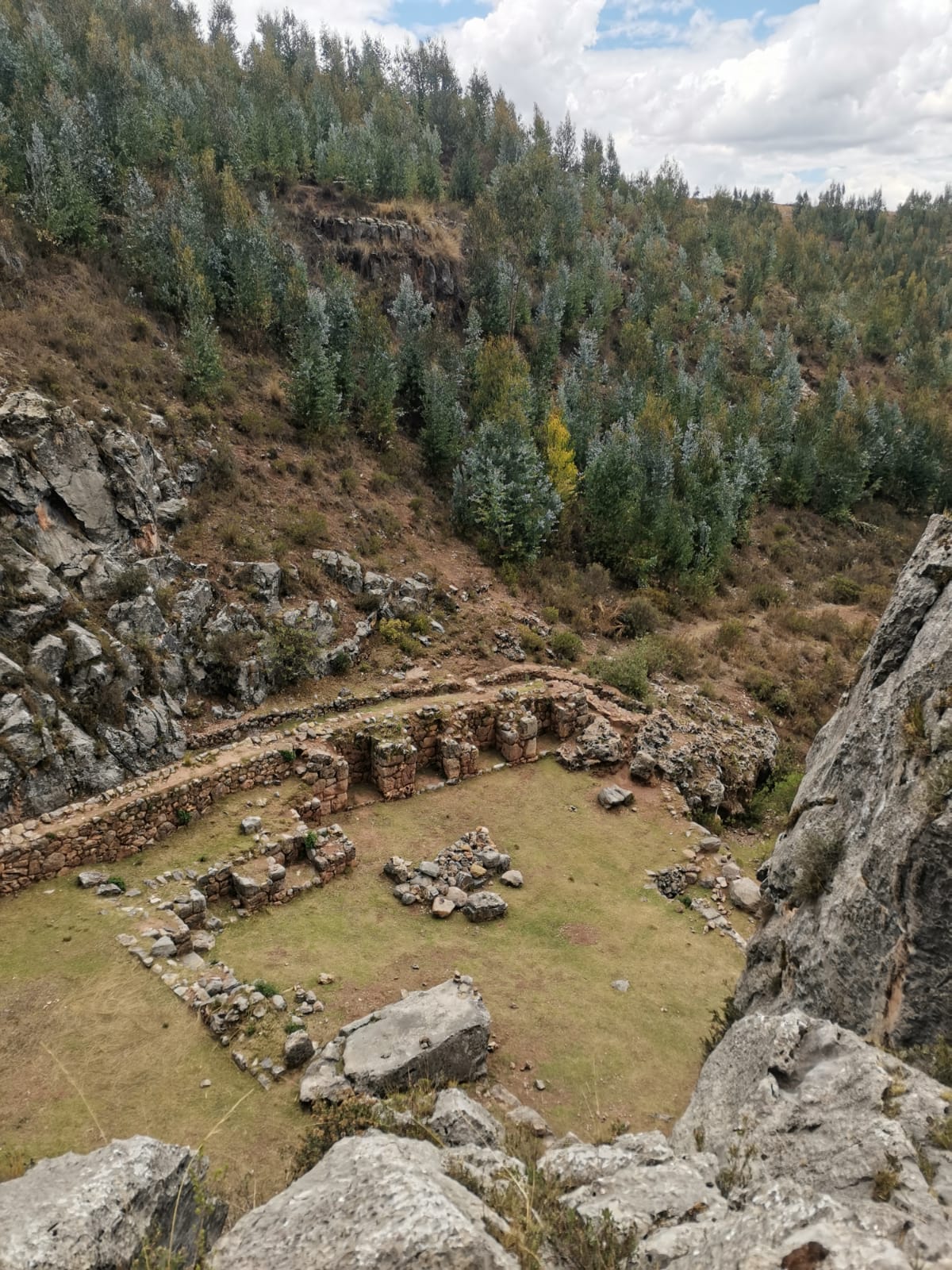 The Inca trail and Machu Picchu are not the only examples of ancient ruins in the Cusco region. Most of the small towns in the region are adjacent to old Incan archaeological sites. In fact, you don't even have to leave Cusco city, with Incan ruins in the centre and on the surrounding hillsides.. Cusco also has a huge range of restaurants and bars, helping visitors recover after long hikes in the mountains. It is easy to find any type of cuisine you desire, with countless vegan and vegetarian options to choose from. Alternatively, you can join the locals and indulge in an array of streetfood at the lively San Pedro market, with some of the freshest produce in the whole of Peru.
The Inca trail and Machu Picchu are not the only examples of ancient ruins in the Cusco region. Most of the small towns in the region are adjacent to old Incan archaeological sites. In fact, you don't even have to leave Cusco city, with Incan ruins in the centre and on the surrounding hillsides.. Cusco also has a huge range of restaurants and bars, helping visitors recover after long hikes in the mountains. It is easy to find any type of cuisine you desire, with countless vegan and vegetarian options to choose from. Alternatively, you can join the locals and indulge in an array of streetfood at the lively San Pedro market, with some of the freshest produce in the whole of Peru.
The Inca Trail
Machu Picchu is the biggest tourist attraction in Peru. There are various routes you can take to visit this legendary citadel above the clouds, from quick day visits to multi-day hikes. The most famous (and unfortunately, therefore most expensive) option is to trek along the Inca Trail, built hundreds of years ago, which crosses through the Andean countriside and leads to the top of Machu Picchu for a privileged view of the site. Over four days, we passed theough arid valleys, windy mountain passes, and dense cloudforests as we made our way to the Incan citadel. The route provides some unforgettable views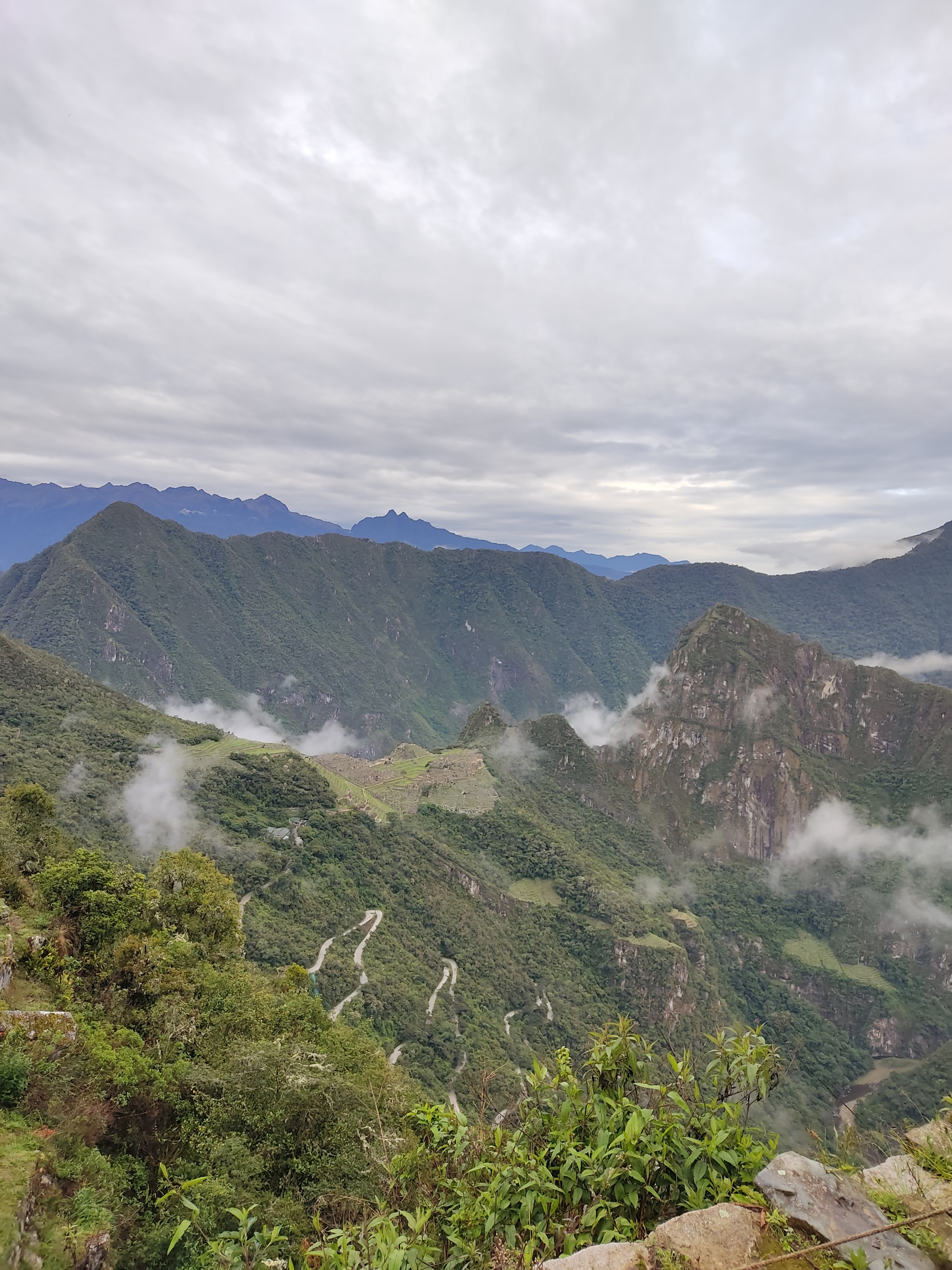 Crossing the Andes, and passing through the different ecosystems along the trail provided a whole spectrum of vistas. Initially, we passed dry and rugged valleys, but these gradually changed to lush green rainforests and cloud-covered mountains. over the remote landscapes, and passes countless Incan ruins
Crossing the Andes, and passing through the different ecosystems along the trail provided a whole spectrum of vistas. Initially, we passed dry and rugged valleys, but these gradually changed to lush green rainforests and cloud-covered mountains. over the remote landscapes, and passes countless Incan ruins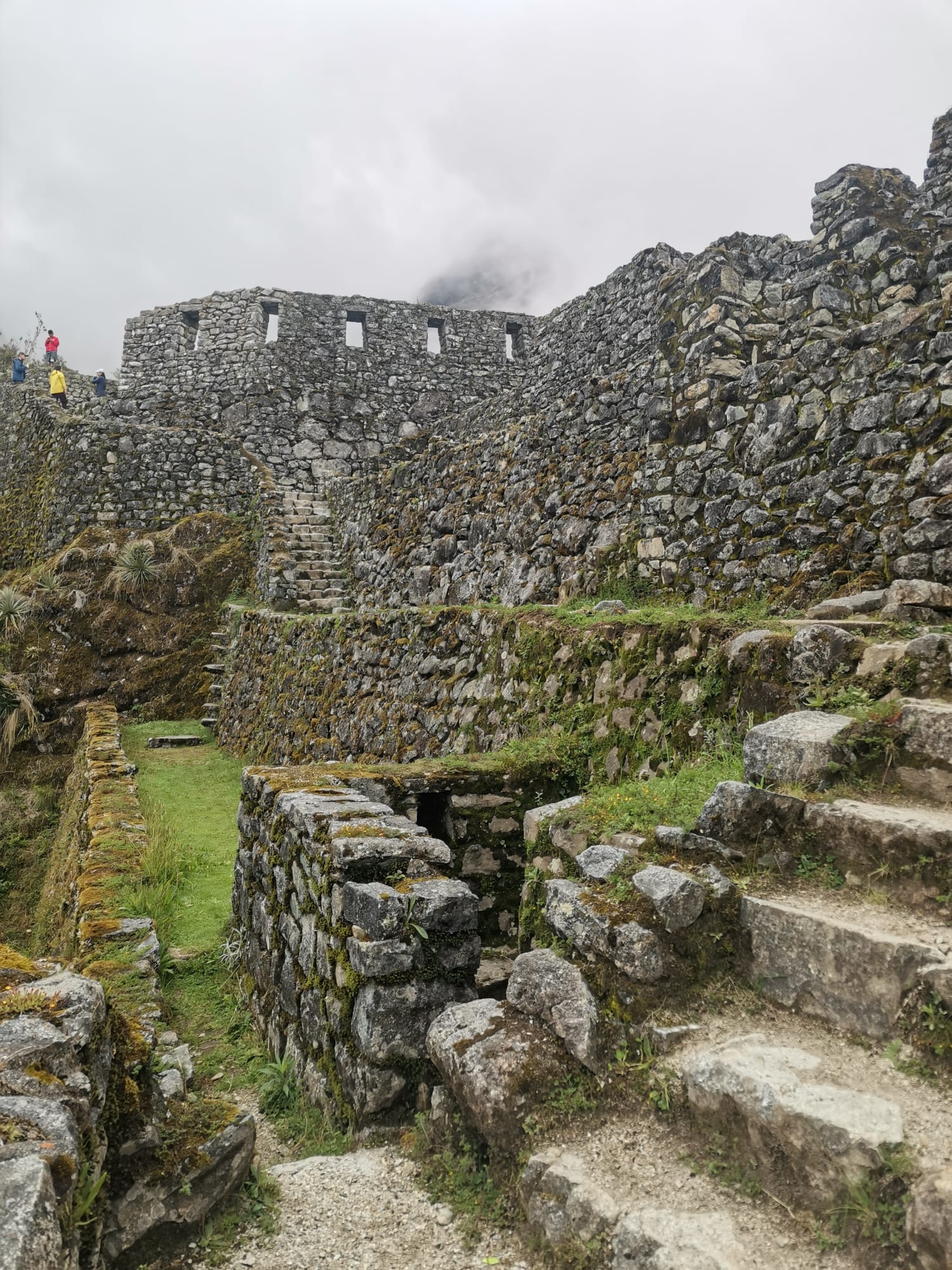 Before arriving at the famous Incan site, we passed old farming terraces, temples, and towns, where we learned about the genius of the Incan construction methods and their religious rituals. en-route to Machu Picchu. We learned so much about the Incan culture and the local wildlife on this trek, all the while being treated to incredible home-cooked meals and comfortable campsites.
Before arriving at the famous Incan site, we passed old farming terraces, temples, and towns, where we learned about the genius of the Incan construction methods and their religious rituals. en-route to Machu Picchu. We learned so much about the Incan culture and the local wildlife on this trek, all the while being treated to incredible home-cooked meals and comfortable campsites.
Puno and Lake Titicaca
After Cusco, we headed to the Bolivian border, making one last stop at Puno. From here we explored some of the islands on lake Titicaca, including the floating Uros islandsUros Islands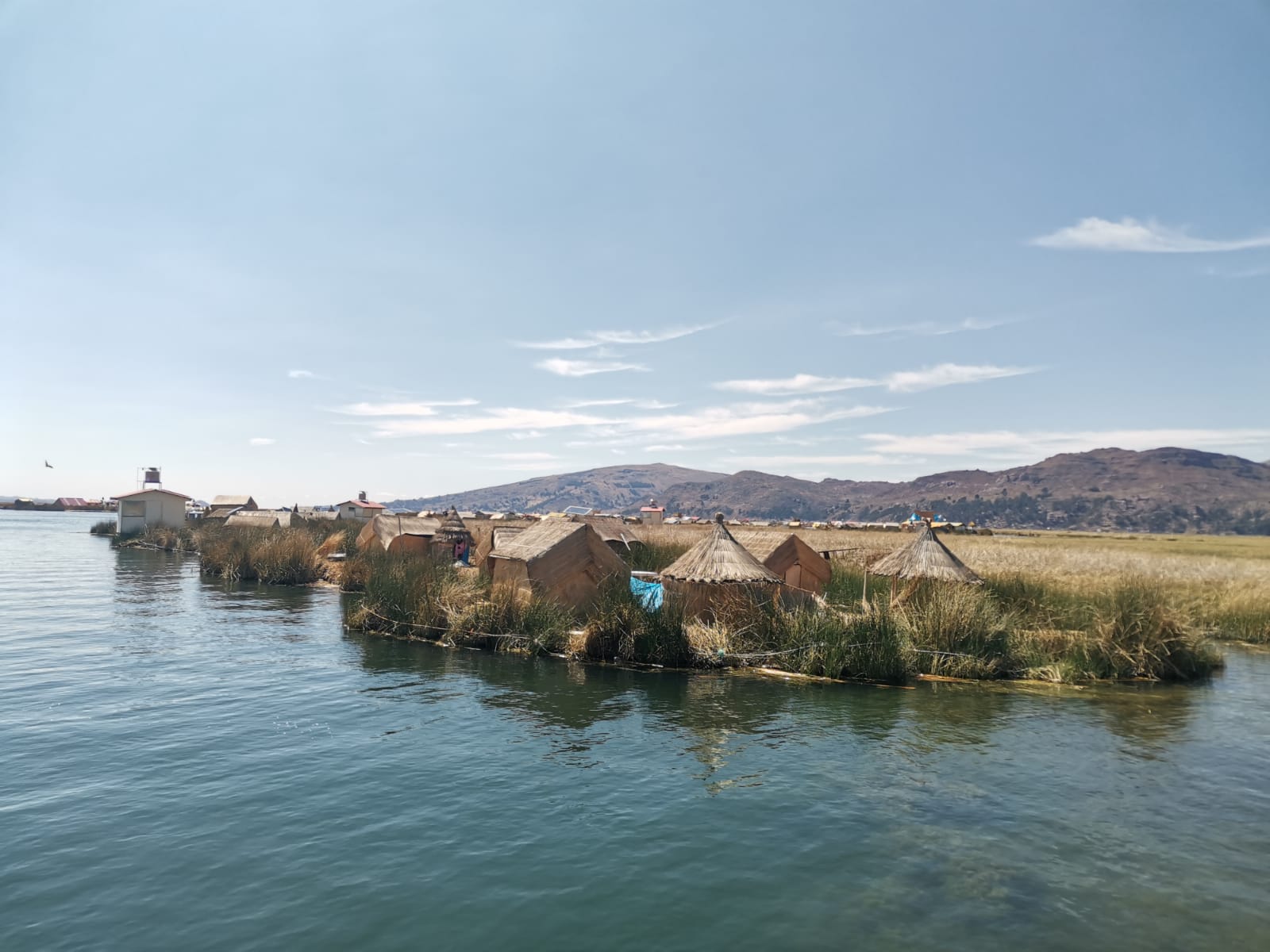 The Uros islands are a marvel of engineering. Made entirely from tortora reeds, these islands float on the surface of lake Titicaca, and are home to an isolated culture of traditional people. and an overnight stay on Amantani islandAmantani Island
The Uros islands are a marvel of engineering. Made entirely from tortora reeds, these islands float on the surface of lake Titicaca, and are home to an isolated culture of traditional people. and an overnight stay on Amantani islandAmantani Island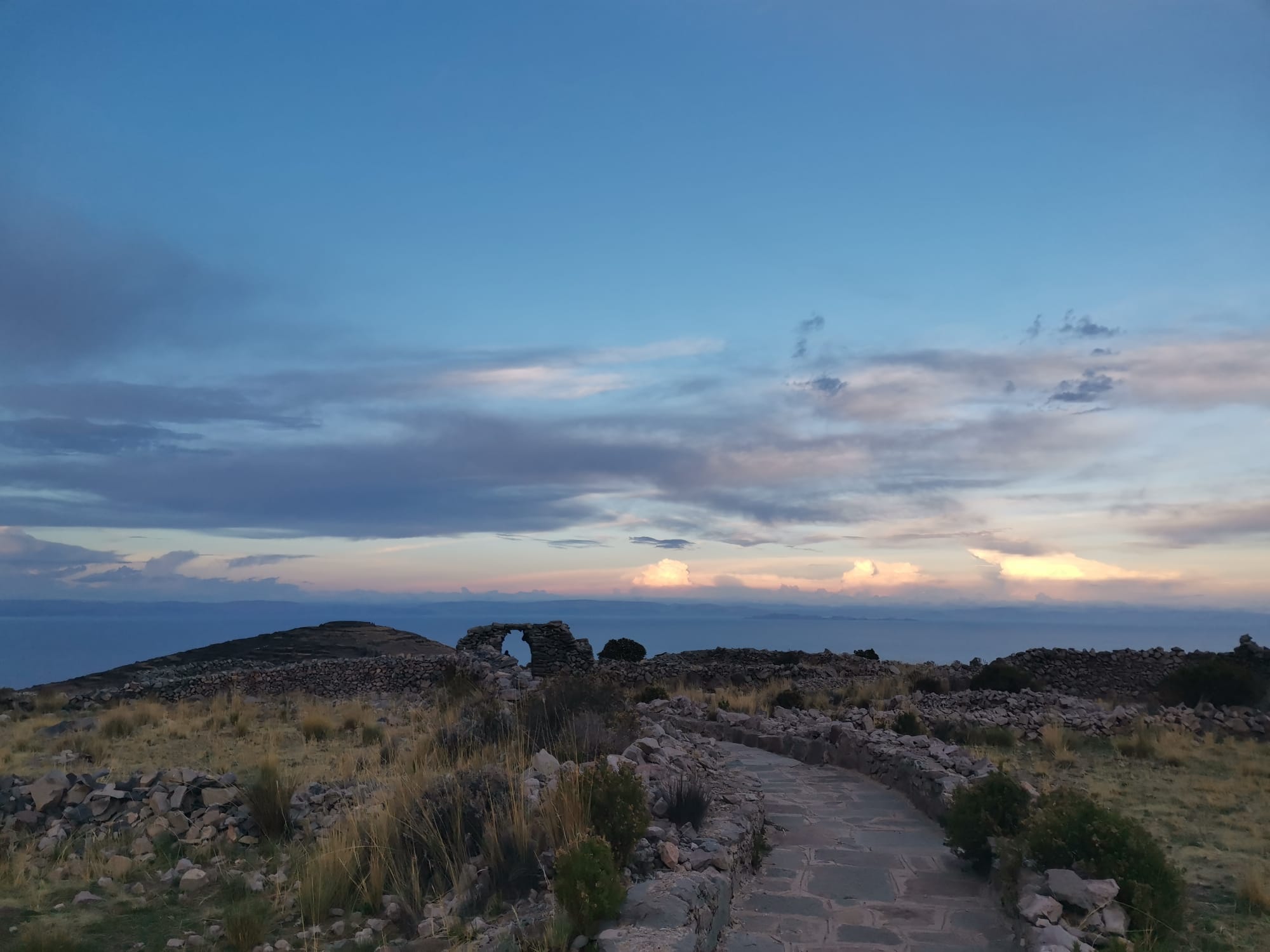 Amantani island is a tranquil and relaxing haven, where the locals are almost exclusively subsistence farmers. The highest peak here provides an unbeatable view over the calm lake.. Finally, we visited Taquile islandTaquile Island
Amantani island is a tranquil and relaxing haven, where the locals are almost exclusively subsistence farmers. The highest peak here provides an unbeatable view over the calm lake.. Finally, we visited Taquile islandTaquile Island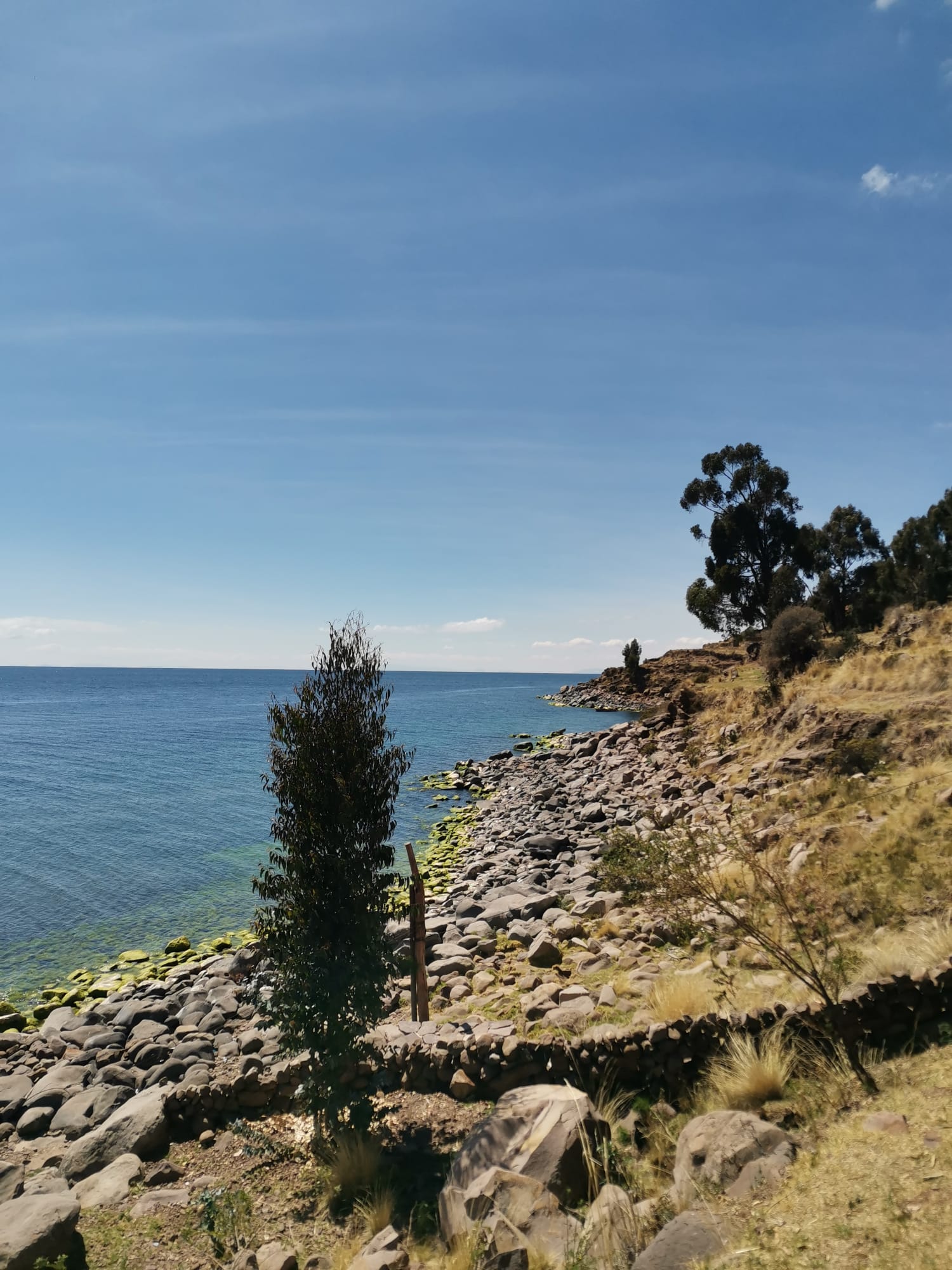 Taquile island is another peaceful spot within the lake. The people here still uphold well-preserved traditions, including high-quality weaving and knitting of textiles, and a unique social structure that requires everyone to take turns working as police or judges., before heading to the border. The highest navigable lake in the World is incredibly laid-back and peaceful, and the local people who live there are super friendly and willing to teach about their traditions and culture.
Taquile island is another peaceful spot within the lake. The people here still uphold well-preserved traditions, including high-quality weaving and knitting of textiles, and a unique social structure that requires everyone to take turns working as police or judges., before heading to the border. The highest navigable lake in the World is incredibly laid-back and peaceful, and the local people who live there are super friendly and willing to teach about their traditions and culture.
Altitude Sickness
Cusco is situated at 3,200m above sea level, and lake Titicaca is even higher, at over 4,000m, so there is a risk of developing altitude sickness there. This is especially common when flying from Lima (at sea level), or other low-altitude cities, to high altitudes above 2,500m, but the effects can be reduced by slowly increasing your body's exposure to high altitudes. In Peru, this can be done by visiting Arequipa, which lies at 2,300m, the perfect altitude to spend a few days acclimatising, without too much risk of experiencing severe symptoms. However, if this slow acclimatisation is not possible, or if you still experience symptoms, it is important to schedule a few days of rest whenever you travel to a higher place. Strenuous activity makes altitude sickness much worse. In the mountains of Peru, you will quickly realise how important coca leaves are for the populations living there. Locals seem to chew these leaves 24/7, and they are a well known way to reduce the nauseating effects of altitude sickness (and stave off hunger). The taste of the dried leaves is not the most pleasant, so most tourists stick to drinking coca tea, which is a much milder treatment.
Where else can I go in Peru?
Although we only explored the South of Peru, between Lima and Cusco, we had heard lots of positive things about the North of the country. There are some popular surfing spots, and some hikes that look truly incredible, so we might just have to come back and explore this part another time!
Transport and Accommodation in Peru
In Peru pretty much the only two ways to get around are by flying or by bus, and we try to avoid taking unnecessary flights. This left us reliant on the Peruvian buses. Throughout the rest of our trip, we used countless local busses, which were a cheap and effective way to get across this huge continent. Peru, however, was a bit different. We had been very highly recommended to use the hop-on hop-off tourist bus company
PeruHopPeruHop provides buses between all the major tourist destinations in Peru, with just a single ticket. They also pick-up and drop-off at hostels and hotels, saving the hassle of arranging taxis.
.Although it was very expensive, we fell for their propagandaThe dire warnings you hear about buses in South America being unsafe and uncomfortable put us off at first. It was only when we went to Bolivia and used their excellent buses that we saw how far from the truth this was. Read about our time in Boliva here. about local buses being risky and their glowing 5-star online reviews, and decided to pay extra for the peace of mind. Despite being astronomically more expensive than any other buses we took, we found the PeruHop service to be frustrating and disappointingWhy we didn't like PeruHop
Although not having to order taxis (which are very cheap in Peru anyway) to/from the bus terminal was helpful, we grew increasingly impatient with the amount of times the PeruHop bus went out of the way to stop off at expensive, touristy shops and restaurants. We wasted hours of our trip sitting in these generic tourist spots when we wanted to be seeing the real Peru. This might be worthwhile for some travellers, but not us. Additionally, there is only 1 PeruHop bus each day, often departing and arriving at inconvenient times. We were frequently left outside our hostels at 5am, hoping someone was awake to let us inside, or having to check-out at 2am and standing in the streets waiting for the PeruHop bus to pick us up. In our opinion, this service did not suit us.. The buses did the job, but if we were to re-do Peru, we would definitely opt for the cheaper local buses that worked well in every other country on our trip. We would have enjoyed our time more, and saved a lot of money to spend on other things. However, if you are keen to avoid organising taxis, restaurants and tours, and want a bus schedule that you can see online, then PeruHop might be for you.
Peru has a strong tourist industry, so accommodation is easy to find on websites like Hostelworld and Booking.com. Peru probably had the widest range of accommodation in South America, but we generally opted to stay in the cheapest hostels, which worked out at around S/.30 (~£6) per person per night. These usually included lockers, baggage storage, a kitchen, and sometimes free breakfastBreakfast in Peru always seemed to be the same, no matter if it was in a hostel, a café, or offered during a tour. The go-to is a cup of tea or coffee, and slighlty tough bread, with some butter and jam, and scrambled eggs., so were really good value. Often, private double rooms cost less than the price of 2 beds in a dorm room, so if you are travelling as a couple or a small group, it can be very cheap to get a private room.
Food, Drink and being Vegetarian in Peru

Traditionally, Peruvian food is heavily focussed around seafood, meats, and potatoes. Unfortunately, as vegetarians, we don’t eat two of those things - and I don’t think anyone would be thrilled at the prospects of eating just potatoes for months on end. Most of the hostels had kitchens, so we ususlly stuck to buying fresh fruit and vegetablesFruit Market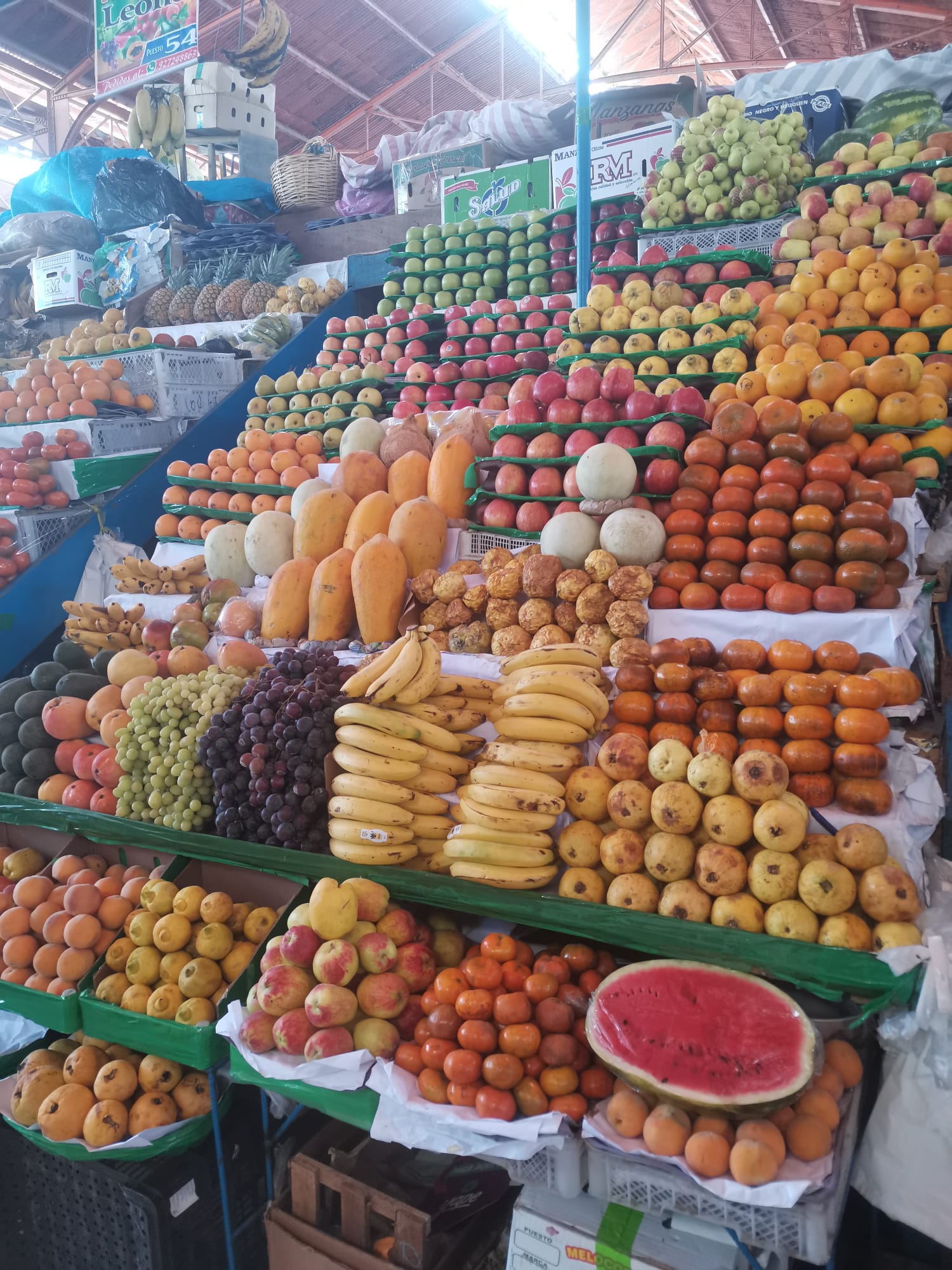 The markets in Peru are an experience in themselves. Rooms with fruit pilled so high it touches the ceiling, friendly greengrocers picking out the ripest and sweetest produce for you, and the people sat with their blenders, ready to make the freshest smoothies in the World. Buying fruit and veg from the markets is not only cheap, but a great way to connect with the locals. from the markets and cooking ourselves, since it was better for our budget than eating out at the tourist restaurants.
The markets in Peru are an experience in themselves. Rooms with fruit pilled so high it touches the ceiling, friendly greengrocers picking out the ripest and sweetest produce for you, and the people sat with their blenders, ready to make the freshest smoothies in the World. Buying fruit and veg from the markets is not only cheap, but a great way to connect with the locals. from the markets and cooking ourselves, since it was better for our budget than eating out at the tourist restaurants.
On lots of the tours though, lunch was included, and we were actually suprised by the quality and variety of food available. We were very grateful for the food on these tours, because it allowed us to try vegetarian versions of the most popular Peruvian meals, like soya lomo saltadoLomo Saltado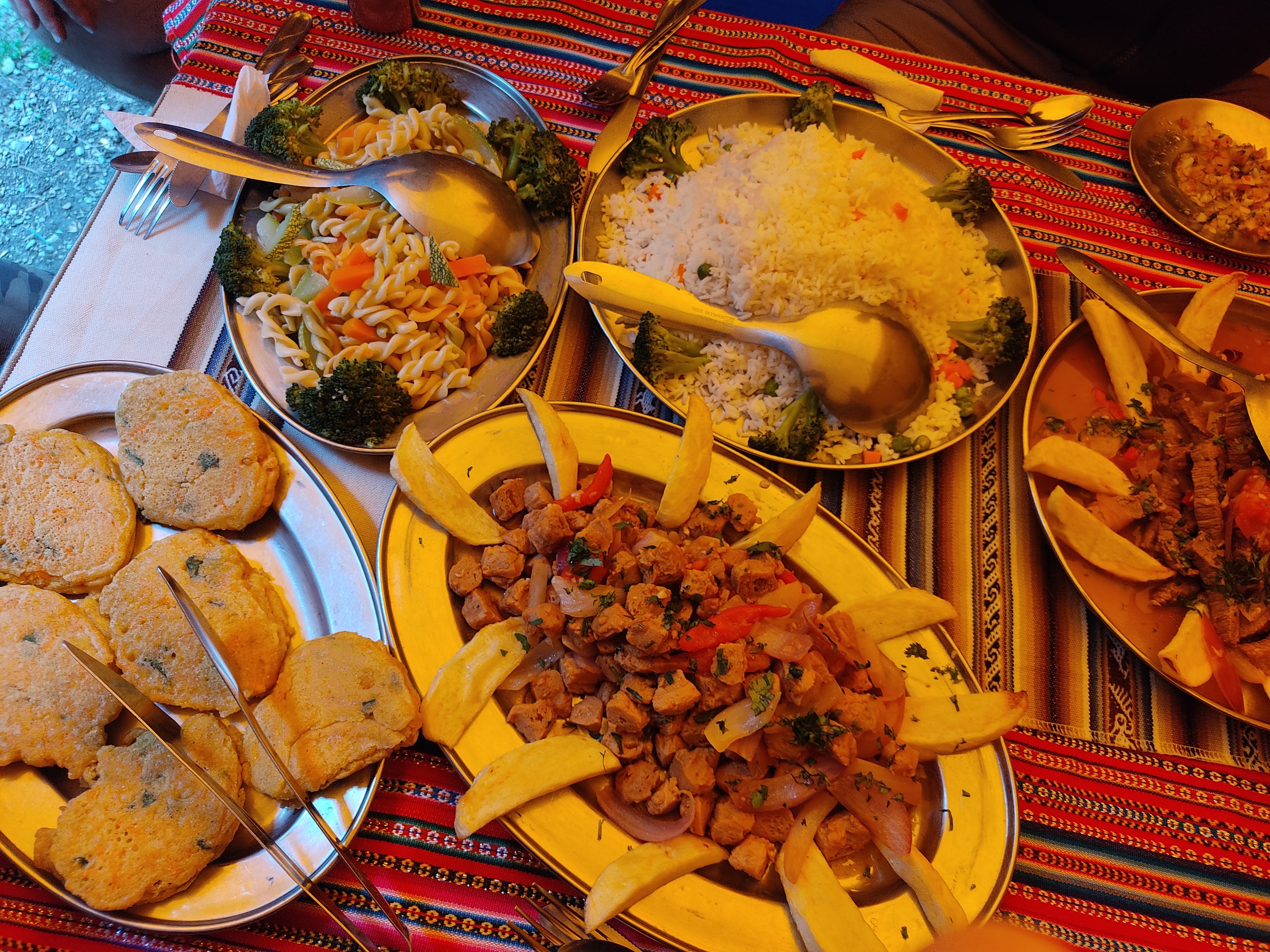 Lomo saltado is a traditional Peruvian dish made from strips of beef (or often alpaca meat), cooked in onions, peppers, and tomatoes, often served with chips and rice. As vegetarians, we never expected to try this dish, but we were made a delicious version in the Colca canyon which used soya chunks in place of the meat. and mango cevicheCeviche
Lomo saltado is a traditional Peruvian dish made from strips of beef (or often alpaca meat), cooked in onions, peppers, and tomatoes, often served with chips and rice. As vegetarians, we never expected to try this dish, but we were made a delicious version in the Colca canyon which used soya chunks in place of the meat. and mango cevicheCeviche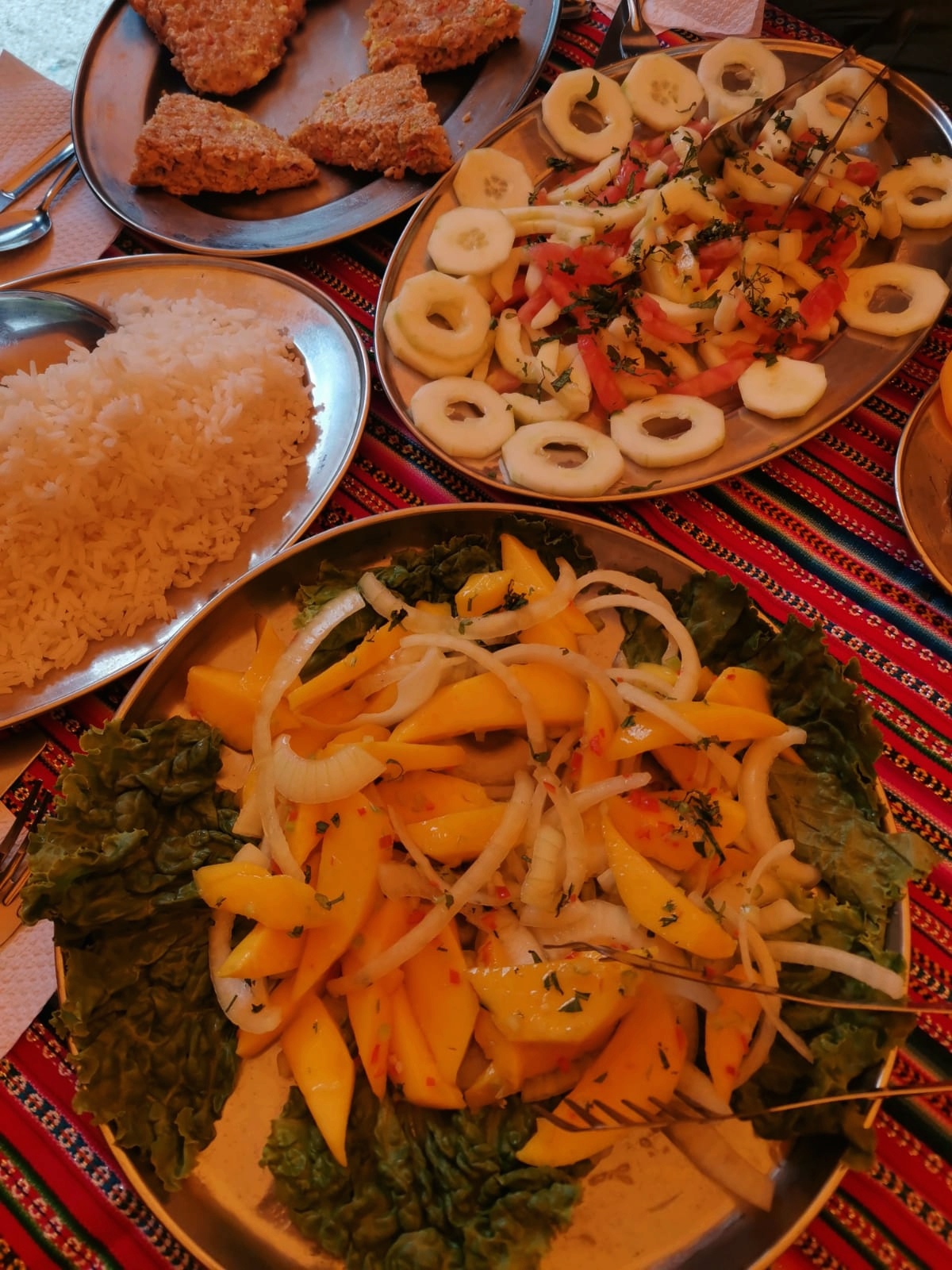 Ceviche is Peru's most famous dish. Every restaurant in Lima advertises their fresh Ceviches to convince tourists to taste this culinary centerpiece. Ceviche is a cold dish of raw fish, marinated in lemon juice and seasoned with herbs. Ceviche is usually reserved for more esteemed restaurants, and on our Inca trail tour, we got to try a cheaper and quicker variation where mango is used instead of fish.. Most meals in Peru are served with a soup starter, which came in so many varieties, but was always vegetarian and often contained a carb like quinoa, rice, or pasta.
Ceviche is Peru's most famous dish. Every restaurant in Lima advertises their fresh Ceviches to convince tourists to taste this culinary centerpiece. Ceviche is a cold dish of raw fish, marinated in lemon juice and seasoned with herbs. Ceviche is usually reserved for more esteemed restaurants, and on our Inca trail tour, we got to try a cheaper and quicker variation where mango is used instead of fish.. Most meals in Peru are served with a soup starter, which came in so many varieties, but was always vegetarian and often contained a carb like quinoa, rice, or pasta.
Fortunately, there are many vegan and vegetarian restaurants in Peru, particularly in the more touristy areas, so it is not hard to find the typical pizzasPizza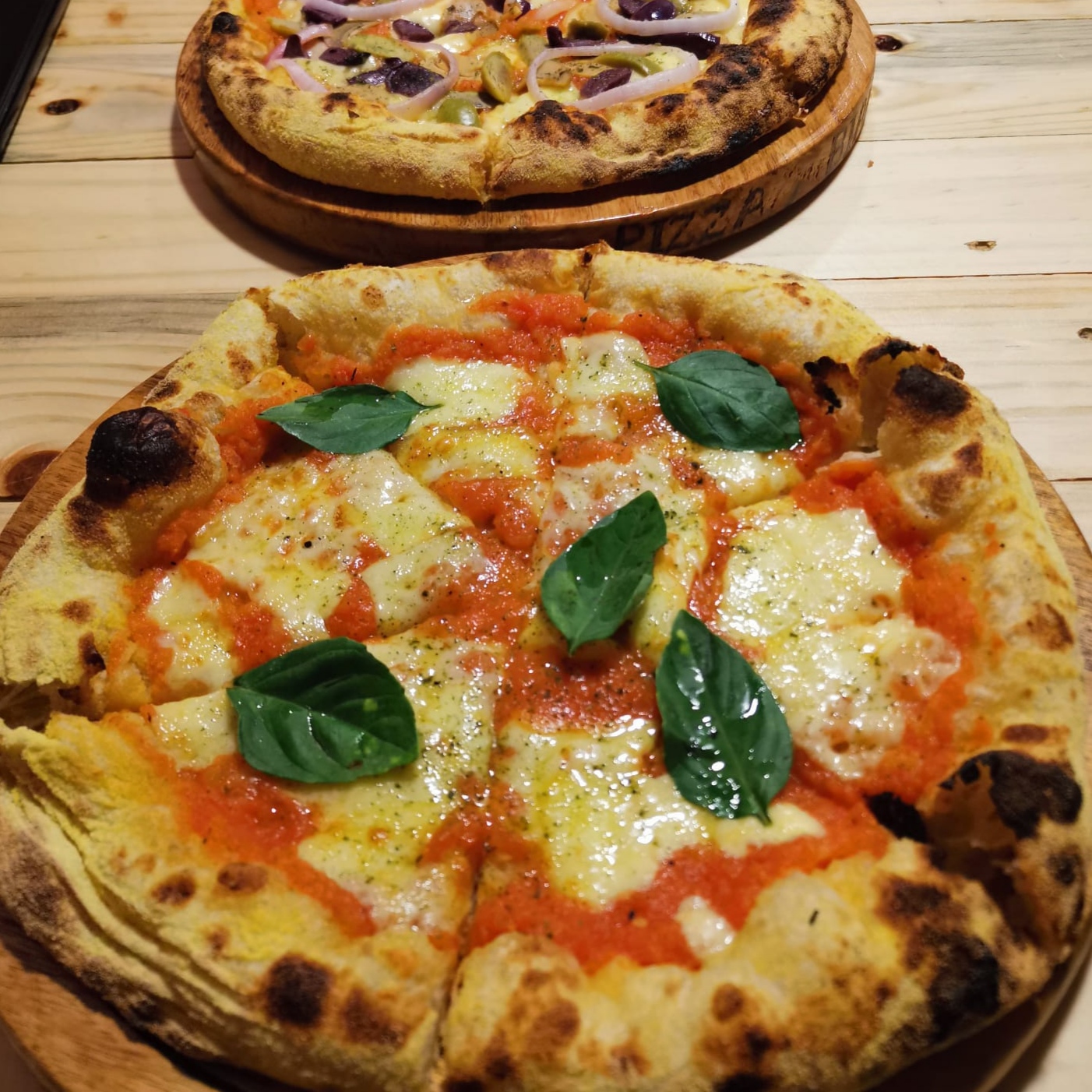 Italian restaurants are always a safe bet for vegetarians! These pizzas from Puno were some of the best we had had in a long time!, burgerVeggie Burgers
Italian restaurants are always a safe bet for vegetarians! These pizzas from Puno were some of the best we had had in a long time!, burgerVeggie Burgers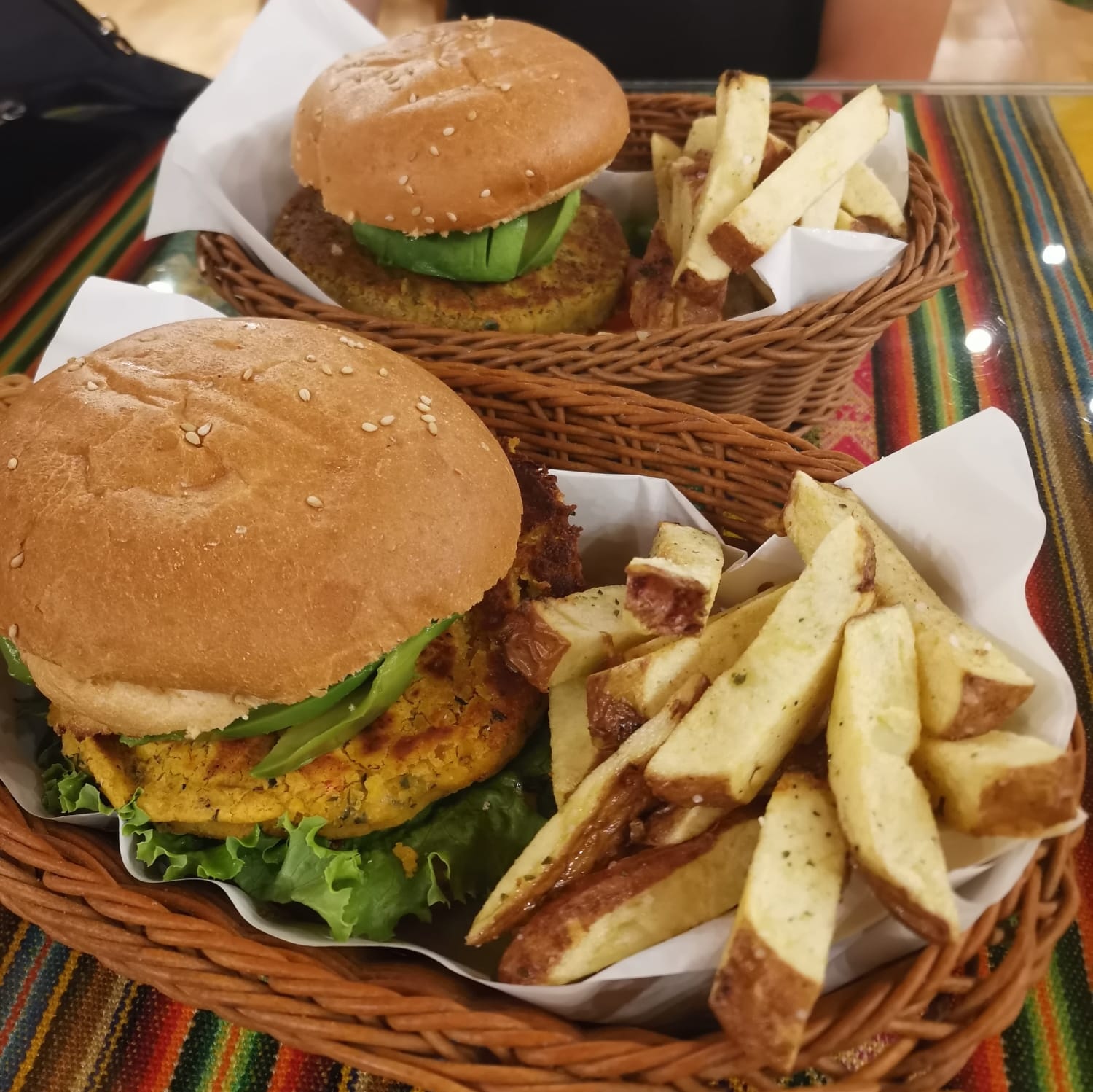
We did not expect Peru to have meet-free burgers, but they were actually quite a common sight. Usually, the veggie burgers are made from quinoa or lentils - two staples in Peruvian cuisine., and curryCurries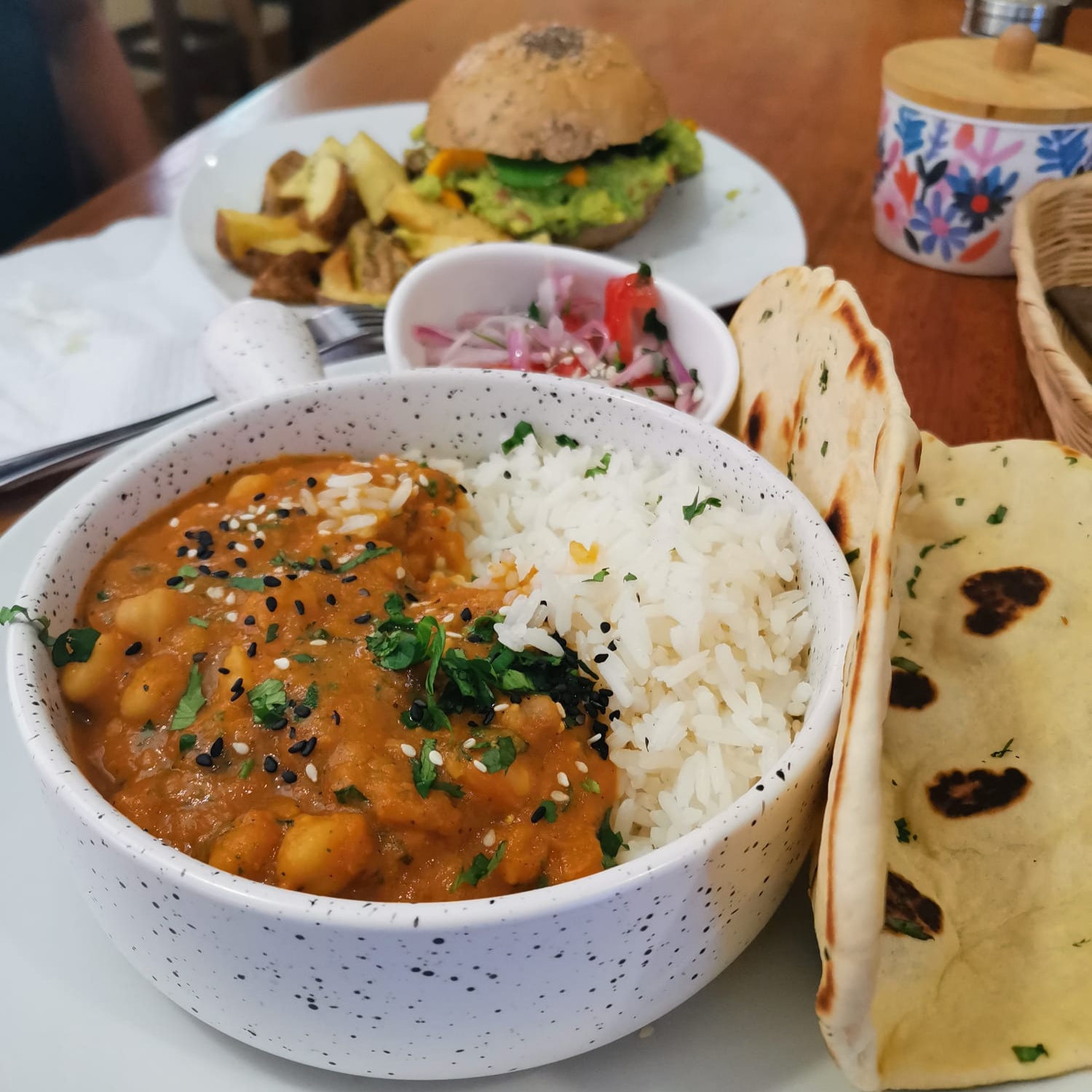 In the more touristy places, it is easy to find places with all-vegan menus, like this one in Pisac which was Indian-inspired. places found in all touristy places.
In the more touristy places, it is easy to find places with all-vegan menus, like this one in Pisac which was Indian-inspired. places found in all touristy places.
The locals rarely go to restaurants, opting instead to eat at one of the numerous street-food stalls dotted around the cities, lining the sides of main raods, and in the bigger markets. These stalls are halfway to actually being restaurants, often with a few plastic tables and chairs set up and a small menu. Thankfully, a lot of these street foodStreet Food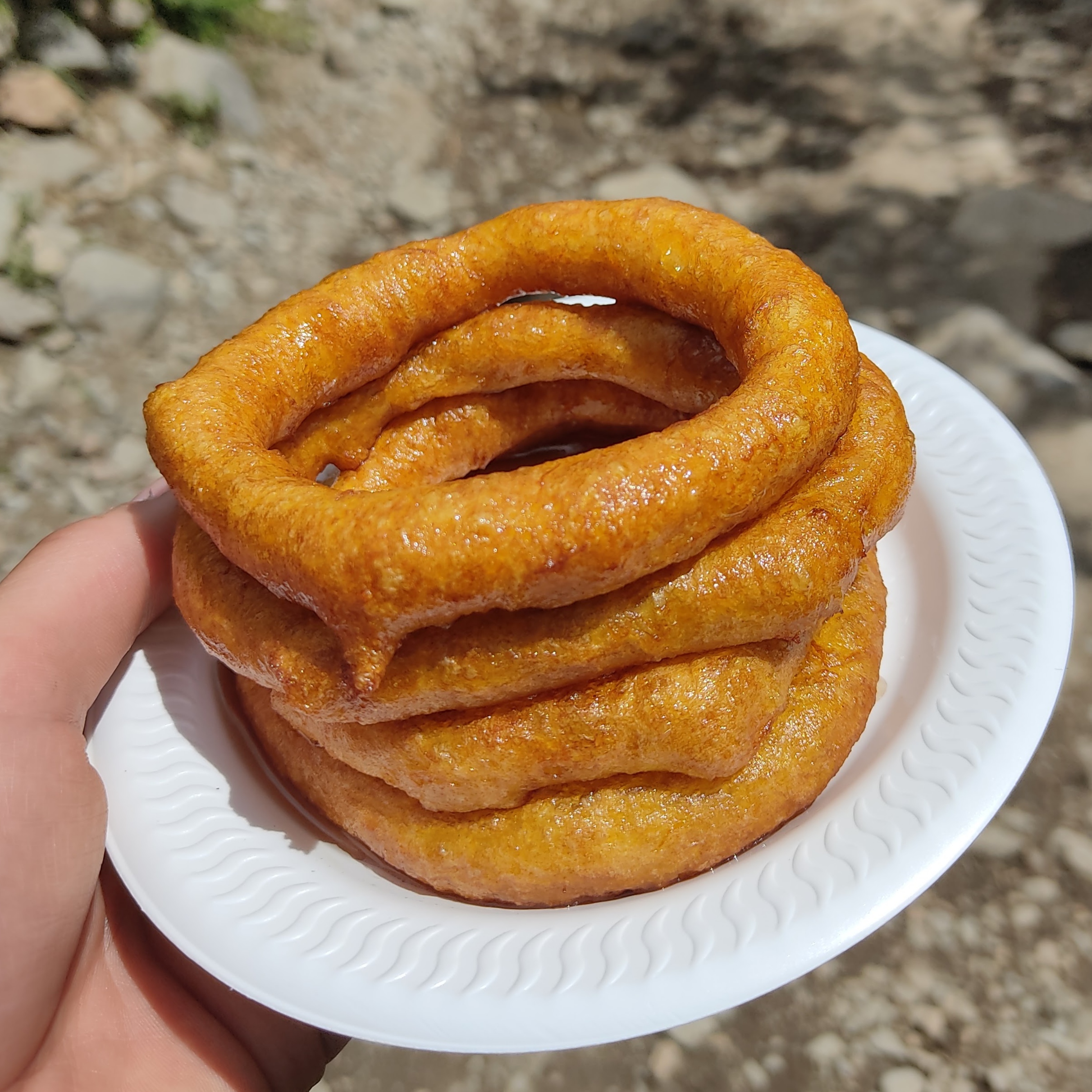
 Street food is huge in Peru. From old men wheeling trolleys full of fresh churros or home-baked cakes around city centres, to large stalls in the local markets offering a daily set menu, you will never struggle to find a quick and cheap meal in Peru. stalls in Peru had vegetarian options as well, ranging from tasty snacks to full 3-course meals.
Street food is huge in Peru. From old men wheeling trolleys full of fresh churros or home-baked cakes around city centres, to large stalls in the local markets offering a daily set menu, you will never struggle to find a quick and cheap meal in Peru. stalls in Peru had vegetarian options as well, ranging from tasty snacks to full 3-course meals.
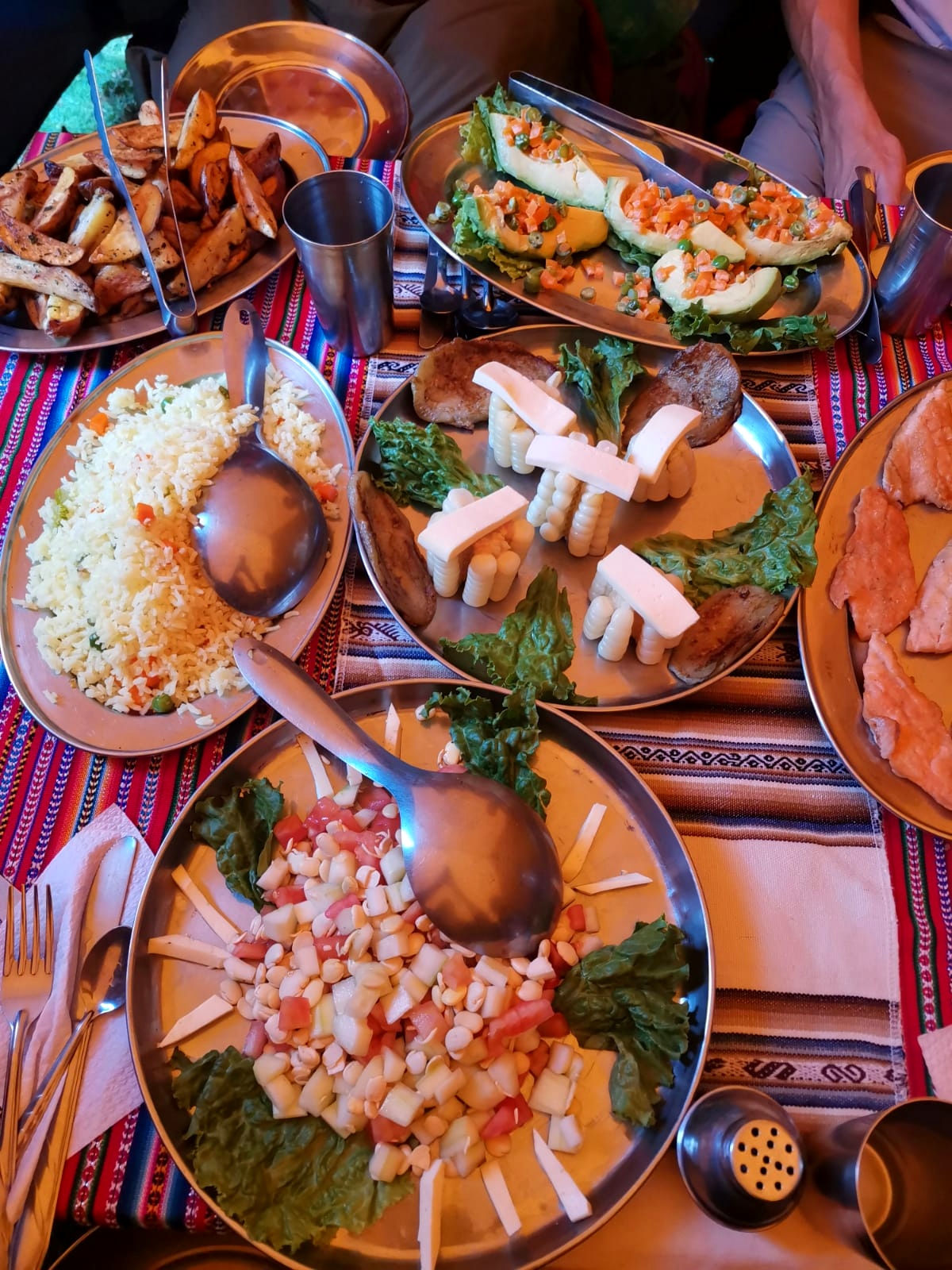

Peru isn't known for its alcohol, like Chile and Argentina, but you will see the national cocktail, Pisco sours, advertised everywhere. Pisco is made from grapes, and it is said that the Peruvians were unsuccessful at making wine so made their own drink instead.
How Expensive is Peru?
Peru has quite low living costs compared to other countries in South America. For food and drinks, a meal at a restaurant cost £8 - £10 for 2 people. For groceries, if you find the places that the locals visit, prices will be very cheap. However, paying for all the tours and excursions can quickly add up. As our first country, we didn't quite have a perfect way of tracking our spending like we did in other countries, but we have rough estimates.
| Category | Spending per person |
% of total |
|---|---|---|
| Accommodation | £4.50 per night | 6.7% |
| Transport | £11 per 100km by bus | 12.4% |
| Tours and activities | £454 | 26.6% |
| Inca Trail Trek | £490 | 28.6% |
| Food, drink, and other | £13.30 per day | 25.7% |
| Total per day | £52 per person |
We have used these metrics to compare each country we visit. Accommodation costs are an average per person, however this includes some nights spent in private double rooms, which would be more expensive for solo travellers. Transport value reflects the average amount we paid per 100km travelled via bus, which is 1hr of travel at 62mph (100kmph). This value tends to vary based on other factors including the route, quality of road surface, and transport company.Tours and activities includes entrance fees and travel costs to/from tourist attractions, and can vary greatly depending on the type of activity. The Inca Trail is listed separately to other tours, since it is very expensive and many people choose cheaper ways to visit Machu Pichu.
Our target for the budget was £33 per person per day. Therefore, the 4-day hike along the Inca Trail was way out of our budget, but we decided it would be worth the cost and so went for it anyway. Although we kept our accommodation and food and drinks as cheap as possible, which meant we had more budget to spend on activities, we could have spent a lot less on tours and transport. After Peru, we began tracking our spending more closely for the rest of our trip to try and bring the overall budget back below the target.
